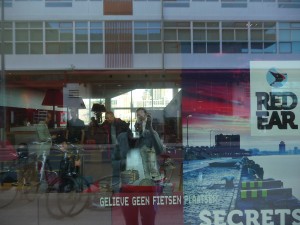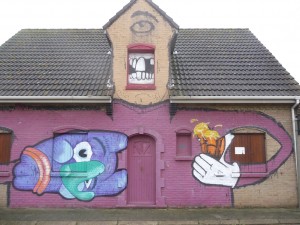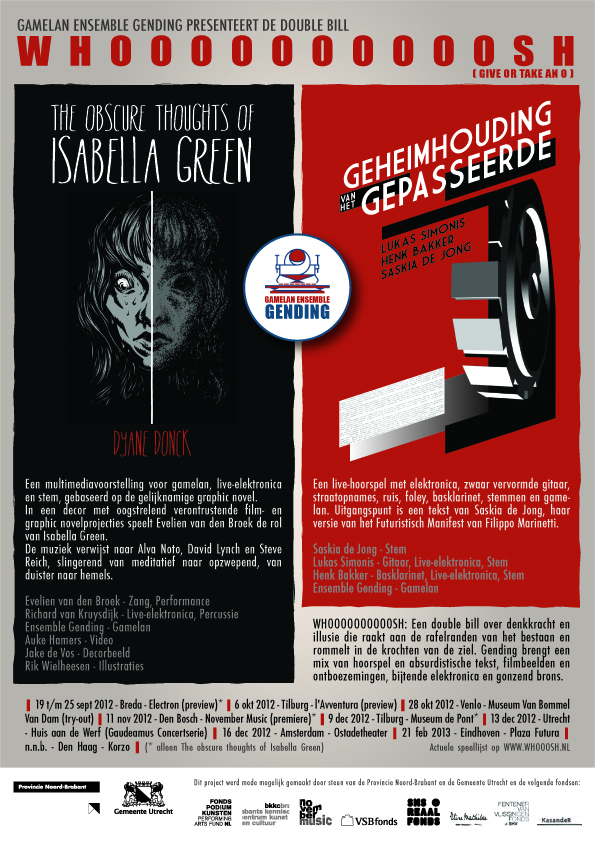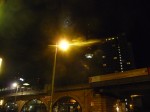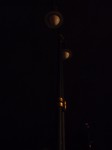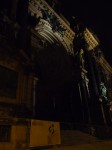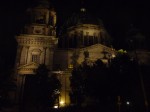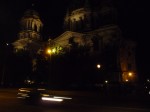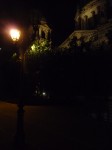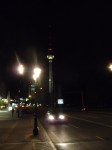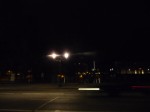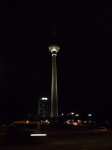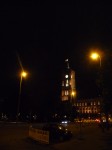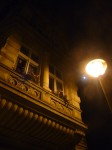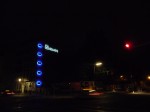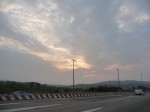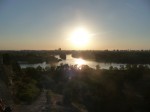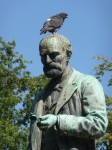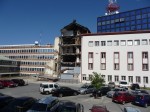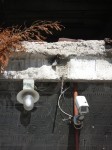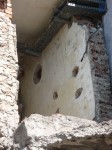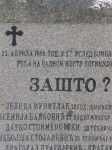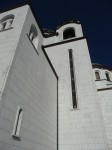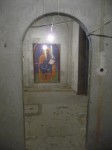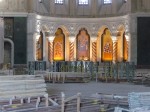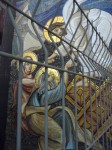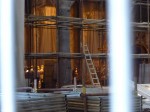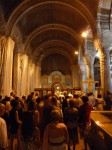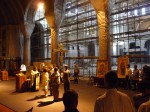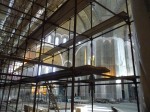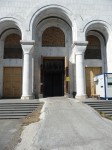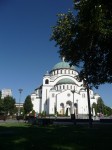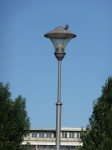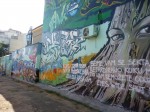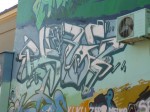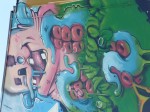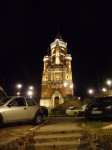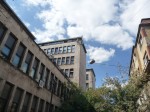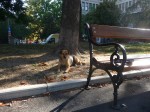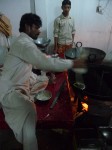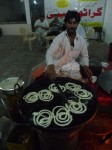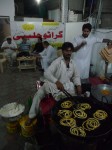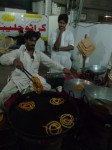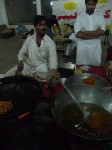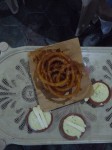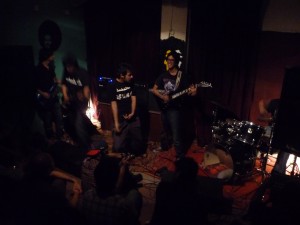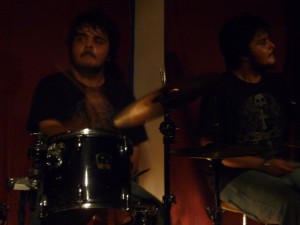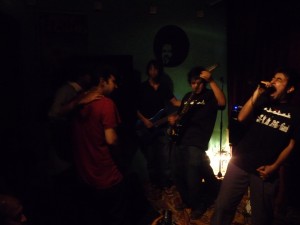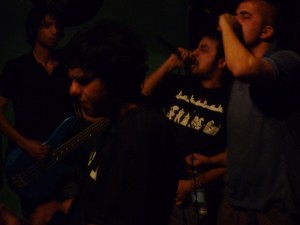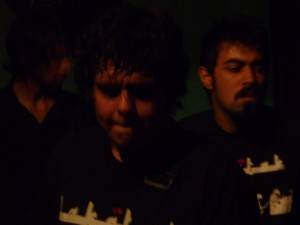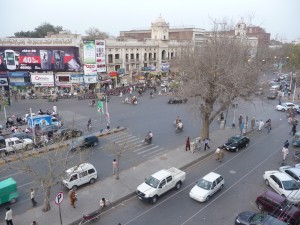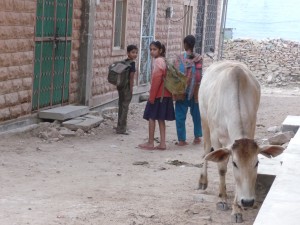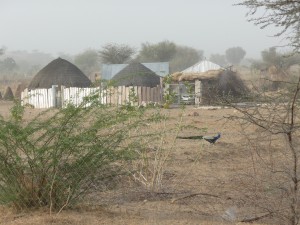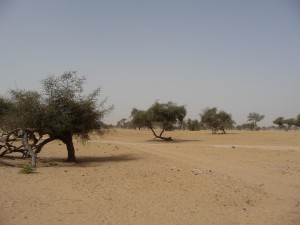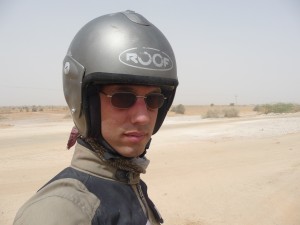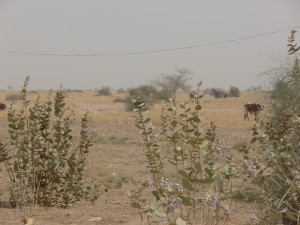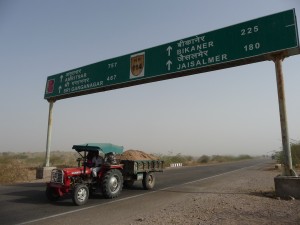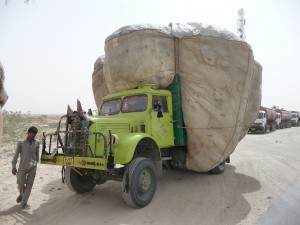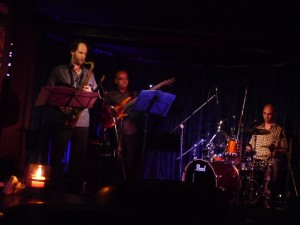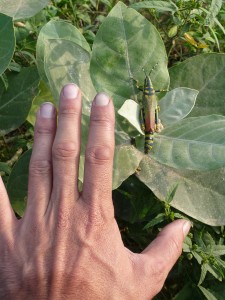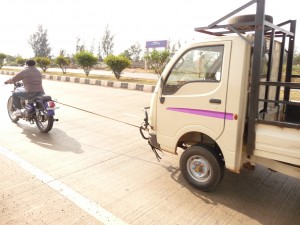into africa with ahaddaf
Poolside in the Chams Hotel, waiting to go to our soundcheck. Whilst Amsterdam seems to have resolutely entered summer, the aforementioned chams – sun in Arabic – is hiding behind a thick layer of dark grey clouds here in Tetouan, on the north coast of Morocco. The swimming pool would be better suited for windsurfing today. My first trip to Africa, and no sun to be seen – this is Nepal all over again.
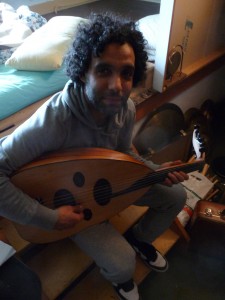
Mo and co-founding member bassist Stephan Raidl taught the new guys the repertoire – pianist Avishai Darash couldn’t do the Moroccan tour either, so Xavi Torres took the job. Mohamed’s music is very melody-based, adds or takes out beats or parts thereof when needed. Try to count it all out and you go mad; sing with the flow and everything is easy and wonderful. The percussion parts are strong grooves, usually played on cajon, darbuka, floor tom, cymbals, and a few more beatable objects. My set-up is closer to a traditional jazz/rock drum kit – so my job as a drummer is to sound like a percussionist who plays like a drummer. Interesting distinction, drums versus percussion – that’ll be a great topic for another post, so check back soon (or simply subscribe).
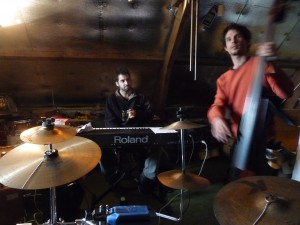
Finally, last night we arrived in Tetouan at some ungodly hour after a long day of plane food & airport limbo. Today was pleasantly slow – espresso and green tea with mint and lots of sugar, getting lost in the medina, admiring the multi-coloured geometric tiles everywhere. And now it’s time to find us a theatre and some sound to check. Looking forward to play tonight, slightly nervous. Oud enthusiasts of the world, stay tuned for further impressions of the Ahaddaf Quartet’s Moroccan tour.
meanwhile, in the hot & dusty south…
When I switched on the wifi on my computer, it didn’t find a single network in the centre of Vellore, a middle-sized town in the hot and dusty plains of Tamil Nadu. Some things in South India do not change, it seems. Women with turmeric-yellow palms and faces, cows roaming the street, men urinating on the the pavement, the scent of sewage and spicy sambar, the leaning piles of paper everywhere in the Ideal Police Station. (And even if new things do arrive, the old stay too.)

My dinner was this trip’s first rava masala dosa, crispy and tasty. Quickly done too, in one of those dimly TL-lit halls, concrete floor and metal crockery banging through the reverb. I had a heavy piece of triple chocolate cake to look forward to whilst battling the mosquitos in my room and going through the results of the recording session, so went looking for some accompanying tea. But alas, it was too late, No tea anywhere, including the stall of the angel-faced chaiwallah next door – matching smile, hairy ork-ears provding counterpoint.
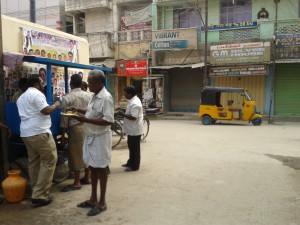
Freshly shaved, I took an autorickshaw to the bus station – and found a large, beautifully fortified temple complex just behind the Ideal Police Station, including guards in matching style. Would have been nice to check out. Next time. After this reacquaintance with South India and a nice stop on my way to a few days of relaxation in Bangalore, I got settled in Madras – make new friends at Hotel Broadlands, practice Indian pharans and American rudiments, unpack my ukulele, and enjoy bookshops and espresso at the Express Avenue Mall. I am now ready for our shows with oto.3, starting tonight, at Counterculture in Whitefield, Bangalore. On to the soundcheck now.
elephant songs in suleymaniyah
October 2013 saw another episode of Elephant Songs, my ongoing project in which musicians from different backgrounds meet and create original music together. This time, the backdrop was Suleymaniyah, the economic heart of Iraqi Kurdistan. An anonymous development aid NGO commissioned me to invite musicians from Iran (where I spent a few months on my drumbiker trip in 2012) and bring them together with colleagues in Suleymaniyah. The resulting line-up could be called a worldjazz quintet: Savel Fatih (Suly) on saxophone (consistently called saxyphone by everyone), Kaveh Kamjou (Tehran) on oud, the bass guitar was played by Ari Ali (Suly), percussion by Arash Lotfi (Tehran), and yours truly (from the low lands, Brussels / Amsterdam) played the drums. We spent a week preparing an evening’s worth of music, leading to a concert at Caffe11 on the night of 10 October. Next to rehearsing, Arash and I taught a rhythm workshop to local musicians too. We played one of the pieces we worked on as the opening piece for the final concert.
The group was a great mixture of cultures and backgrounds. Ari lived in Baghdad for most of his adult life and claimed his Arabic might be better than his Kurdish. Meanwhile Kaveh, though living in Tehran since a long time, is an Iranian Kurd and as it turned out, his Kermanshah Kurdish and Iraqi Kurdish were close enough to be mutually understandable. The Iranian language Farsi itself is apparently not too distant from Kurdish and moreover many Kurds speak it, so the week’s communication sounded in at least three languages. From a musical perspective, Savel is equally happy inventing folklorish songs, like the tune Fisherman Culture he contributed, and playing American jazz traditionals – in fact he suggested to play the classic Scott Joplin hit The Entertainer, the only non-original piece of the evening. Arash is at least as proud of his Persian music skills as of his vast knowledge of European classical music, while your humble correspondent has dabbled in a few different traditions himself as well.
Creating new music with a group as diverse as this is obviously not without challenges. “This melody has no good place on my instrument”, someone said when someone else was trying to teach them a new song. How to respect people’s backgrounds & preferences whilst still daring to challenge them? This question was faced by all of us, as we all took turns in leading the creation of a piece.
Savel came up with the afore-mentioned Fisherman Culture, on a groove that Arash was playing around with. Kaveh brought a beautiful tune he called Khazan, Farsi for autumn – the season that was just beginning. Arash and I devised some rhythmical games for the introduction. Arash has been exploring the mouth harp in recent times – as he already showed in last year’s improvised trio gig in Tehran (featuring Kaveh as well) – and wanted to create a piece showcasing five different ones. This resulted in his Lab Chang Concerto – including kadenzen, of course – that we tried out in a few places before the official show, the Shaeb Chaikhana among them. Ari contributed a very danceable reggae version of the traditional Kurdish melody Hewraman that he recently discovered working on another project, and finally my melody Muggosphere got a new treatment, including some fantastic oud work by Kaveh.
I made a short documentary about the process of creating music together, about beginnings of beautiful friendships, showing markets and people, tea houses and coffee bars. And stroopwafels. Enjoy!
elephant song birth, a short documentary about the elephant songs music meeting in suleymaniyah, iraqi kurdistan, in october 2013
The show was filmed by the great San Saravan and his friend Rebin Jaza; many others – including all musicians, cultural network wizard Neil van der Linden and surprise-visitor (and my father) Jan van Hulzen – have pointed cameras at whatever they considered relevant, funny, useful, or otherwise interesting enough to save for posterity.
Elephant Songs in Suleymaniyah was another fantastic project. I’m currently working on new plans involving Tehran and possible Tajikistan, stay tuned for updates. Meanwhile, let’s see the response this doculette will generate. Any thoughts, criticisms, suggestions welcome.
escapism
Waiting for Erik Gustafson of EPIC to talk about elephant songs for his Iraq Matters podcast over more than decent espresso at the Rand Gallery, Suleymaniyah. It’s the second day of Eid and the place is swarming with fifteen-year olds, grouped along gender lines and looking their best: skinny jeans, bow ties, pink polyester dresses, and, for the boys, the incomprehensible middle-eastern haircut – clipped close down the sides and back and a big mop on top, often asymmetrically shaped for heightened effect. The girls taller than the boys, who try to compensate with shadowy upper lips and studied-casual smoking around the bathrooms.
I’ve escaped my room – edit central, these days. How does one turn 20 hours of film into a 20-minute documentary? I’ve done a lot of short clips, but this is new. And exciting, obviously, but I need a break.
Although I must admit it’s not the first escapist move today – after cataloguing and reviewing all my material over the last few days, I felt like doing something concrete, and threw together a quick-and-dirty edit of the song Hewraman from our show at Caffe11 last Thursday, based on an idea by Ari Ali. The static camera was operated by Rebin Jaza, the moving images were shot by film maker and bear saviour San Saravan.
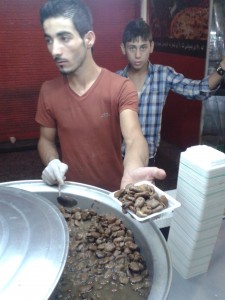
teatime with the people
After arriving in hot and bone-dry Suleymaniyah a week ago I unpacked half my backpack, met up with my fellow musicians (happy reunions and pleasant nice-to-meet-yous), and we started working. We had a week to come up with a repertoire for the band, and were also intitiating a small group of enthousiastic local percussionists in the ancient arts of Indian rhythm and Balinese monkey dance. Lots to do. But on Tehrani percussionist and old friend Arash’s insistence, we took a one extended lunch break at the bazaar after a few days.
The core of our excursion was a visit to the legendary Shaeb Chaikhana, the People’s Teahouse. Frequented, supposedly, by artists and intellectuals (the male variety) who all drink strong black tea with too much sugar (“don’t stir!” is the advice to non-suspecting foreigners like yours truly) from iconic hourglasses and play backgammon and dominos. The noisier the better: the incessant banter and thick cigarette smoke are complemented with the clack-clack of ivory on ebony boards. (Or is it just wood and plastic.) The walls are lined with portraits of a whole variety of writers and thinkers and other inspirational characters, including a Dutch journalist who died here a few years back – the only woman to be eternalised on the walls here. Or, for that matter, to be seen anywhere on the premises. Arash, full of initiative and unafraid as always, went straight to the proprietor, shook both his hands and with his beautiful mixture of enthousiasm and humbleness asked him if we could come and play.
The only thing the man needed to know was when, the if was clearly not an issue. We settled on Thursday, panj shanbe in Farsi and something close enough in Kurdish.
A few days later we arrived at the teahouse with our cajon and jew’s harps after a hilarious taxi drive. We set up in a corner and started playing. I had no idea what to expect – would the be annoyed? amused? would they ignore us or enjoy our music, tell us to stop or buy us tea? Turned out we were actually quite welcome: while a large number of men simply continued playing their games, others came and stood around us, applauding enthousiastically and indeed bringing us more hot and sticky glasses. We tried out our mouth harp feature, which we were working on for the Caffe11 gig. We call it the lab chang concerto. (The actual Farsi name of the instrument is zanburak, but Arash prefers its Tajikistani name. And by doing so confuses the earwax out of everyone.)
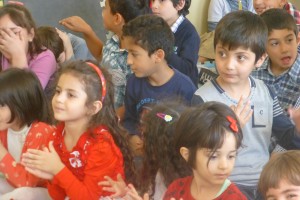 Besides the teahouse king, one of our new best friends here is the dean of the French school. We met her in the garden of Caffe11 one afternoon and got talking, like you do. We (enthousiastic Arash again, to be precise) offered her to come and play for her kids, and indeed we spent a lovely morning with some fifty kids of primary school age, clapping and moving along to the music. The tallest girl (you know how girls at some point just shoot up, becoming a head taller than all the surrounding boys?) shyly asked if she could do a très court dance and, armed with our visiting friend Neil’s FC Utrecht scarf, started moving to the music gracefully. To be joined within minutes by almost the entire group, to the amusement and endearment of most (including us, obviously) and the disapproval of some of the stricter teachers. Though rowdy clapping and yelling was acceptable for everyone.
Besides the teahouse king, one of our new best friends here is the dean of the French school. We met her in the garden of Caffe11 one afternoon and got talking, like you do. We (enthousiastic Arash again, to be precise) offered her to come and play for her kids, and indeed we spent a lovely morning with some fifty kids of primary school age, clapping and moving along to the music. The tallest girl (you know how girls at some point just shoot up, becoming a head taller than all the surrounding boys?) shyly asked if she could do a très court dance and, armed with our visiting friend Neil’s FC Utrecht scarf, started moving to the music gracefully. To be joined within minutes by almost the entire group, to the amusement and endearment of most (including us, obviously) and the disapproval of some of the stricter teachers. Though rowdy clapping and yelling was acceptable for everyone.
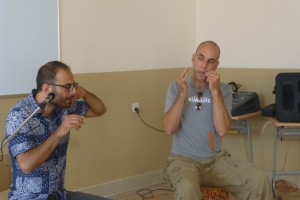 Yet another expedition led us to the College of Fine Arts. Filming outdoors on the campus was no problem for the pointedly present police (bullet proof vests and guns that put me straight back in Pakistan) but the school’s security staff came and told me off. Once inside, we found ourselves in front of a crowd of students of composition, performance, and ethnomusicology. We had a nice chat about their views, methods, expecations and so on, including a discussion of the term ethnomusicology. Not a favourite of mine, but they insisted that it was important as the additive “ethno” indicates that there is fieldwork involved, rather than the pure literature study they considered “musicology” to be. Unfortunately we couldn’t play “just yet” and were also not allowed to film. To discuss this, we were introduced to their professor. A brilliant man who studied composition in Belfast and played us a beautiful (and very advanced) string quartet he wrote for the Arditti Quartet a few years back. He somewhat reluctantly gave us permission to film at least our talks with the students but when we got back to the students’ classroom they’d all left for lunch. We were expected back at the ranch too and left, happy with the chats and hoping to keep in touch with dr Abdullah.
Yet another expedition led us to the College of Fine Arts. Filming outdoors on the campus was no problem for the pointedly present police (bullet proof vests and guns that put me straight back in Pakistan) but the school’s security staff came and told me off. Once inside, we found ourselves in front of a crowd of students of composition, performance, and ethnomusicology. We had a nice chat about their views, methods, expecations and so on, including a discussion of the term ethnomusicology. Not a favourite of mine, but they insisted that it was important as the additive “ethno” indicates that there is fieldwork involved, rather than the pure literature study they considered “musicology” to be. Unfortunately we couldn’t play “just yet” and were also not allowed to film. To discuss this, we were introduced to their professor. A brilliant man who studied composition in Belfast and played us a beautiful (and very advanced) string quartet he wrote for the Arditti Quartet a few years back. He somewhat reluctantly gave us permission to film at least our talks with the students but when we got back to the students’ classroom they’d all left for lunch. We were expected back at the ranch too and left, happy with the chats and hoping to keep in touch with dr Abdullah.
And after all this, we’re now getting ready for tonight’s festivities here at Caffe 11. Looking forward, excited and curious how we’ll get through the repertoire of diverse and sometimes fairly complex pieces we whipped up in the last week. Khaheem deed, we shall see. (Yes I know it’s Farsi but enough people here speak the Iranian language and enough Kurdish words are pretty close to give me the idea that linguistically I at least somewhat relate to where I am.) A report, including a short documentary about the whole project, will follow shortly, inshallah.
elephant on the road
First time I’m on an airplane in a long time (my last flight was a domestic Indian Anand-Delhi blitzrun more than a year ago when I unexpectedly needed a No Objection Certificate from the Dutch Embassy to obtain a visa for Pakistan, the first country to cross after leaving India on my way to the lowlands on an old motorcycle loaded with drums). Take-off will always be a miracle, the rest is as tedious as it ever was. The air host family is currently doing their dance of the trolleys – back and forth and back and forth and just when you think they’re ready to serve you that much-desired drink (any liquid would do fine at this point, when insides of noses have turned into brittle crusts), they back away to the other end of the tube again. The atmosphere is dry and hot, and I’m filled with anticipation of what will happen on the other side of air travel limbo. I’m on my way to Suleymaniyah, in Kurdish Iraq, to do an Elephant Songs project with local musicians and Iranians I met on my drumbiker trip last year. The adventure is commissioned by a Dutch NGO.
Though originally intended to celebrate no rouz, this part of the world’s new year celebration on 21 March, the festivities in Suleymaniyah proved a little more difficult to organise than expected. So much so that I lost some of the Iranian musicians I invited – clarinettist Rouzbeh whom I so pleasantly worked with last year, and santoor player Kayvan Farzin whom I was looking forward to meet both had to accept other gigs when the event dates remained unclear for months. (As it happens, Rouzbeh and his band Pallett will be in Europe while I’m in Iraq; with a bit of luck I’ll join them for a bit when I return.) In addition, two classical instrumentalists from Tehran I would have loved to have in the band couldn’t find a way to travel; they considered the overland border crossing too dangerous for female musicians.
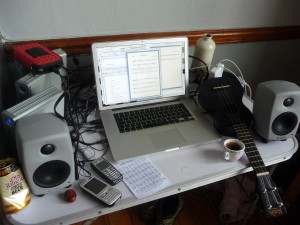
Touchdown in a few hours, no idea where I’ll sleep but all will be well. Looking forward to a week of music, nice weather, catching up with friends, reportedly good coffee at our rehearsal and concert venue Caffe 11. Once again travelling to play music. Curious & excited about the collaboration, the audience and their reactions, the artistic results. For those of you who won’t make it to Suleymaniyah on 10 October, I’ll post a 20 minute documentary some time in the week following the festivities.
dinner music
|
One, two, three, go! Freestyle. No prior agreements about form, key, mood. Just act, and react. An intense form of working together, especially with people you haven’t played with before – will vocabularies match, will we “feel” each other enough to follow, contrast, complement each other? Do our repertoires of tricks and phrases work with the others’, do we inspire each other enough to find ways together, surprise ourselves, challenge and feed each other, and above all create interesting music?
Whether we succeeded? That I leave to you to decide, dear listener. But I had a fantastic evening.
The Red Ear Restaurant Tour was organised by Hajo Doorn & Worm. Suyin Gisela Ridderstaat took photos.
Hans Wessels made a short film clip about the festival.
snowflakes & pancakes
Quoi? Ehm no, we didn’t. He pulled down the corners of his mouth, but showed us a table when we announced we just wanted to have a drink. Something hot for me, underdressed as always, and a Belgian beer for Anna. Its taste led to a lecture on high versus low fermentation by the waiter, who had turned unhurriedly friendly as soon as we’d settled down comfortably in restaurant De Molen, in the shadow of the nuclear power plant in Doel, Oost Vlaanderen.
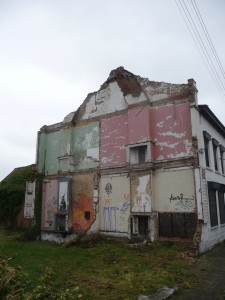 Anna had invited me to come along as part of her Urbex Night Photography project. With her camper van she travels to remote locations all over Europe, to take photos in deserted buildings at night. She adds to this particular kind of urban exploration by asking artists from other disciplines to create a work of their own, using the environment.
Anna had invited me to come along as part of her Urbex Night Photography project. With her camper van she travels to remote locations all over Europe, to take photos in deserted buildings at night. She adds to this particular kind of urban exploration by asking artists from other disciplines to create a work of their own, using the environment.
My original idea was to bring some drums and other sound makers and film and record them in different spaces, so I could make a film of a few minutes in which the varying accoustics shape a piece of music. But when I realised most spaces in Doel are abandoned houses with similar acoustics, I discarded the idea of bringing stuff and decided to use sounds I hoped to find there.
Before fleeing into the restaurant, we’d been walking through the village, looking for good spots. Found a house with promising spaces for photography and a lot of things that could make sound: bits of metal, cans, and best of all, an enormous fuel tank with a beautiful low boom in the garden. Cracked eaves provided the groove for my piece, polyrhythmic water drops that I amplified by placing plastic jerrycans under the drip. A great collection of sounds and images, to be captured when it was light again the next day.

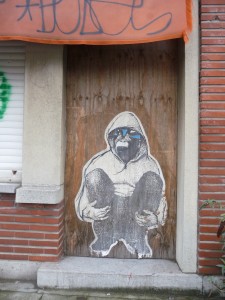
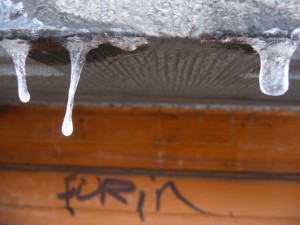
Next: our garden. The gardeners just outside (what exactly is the park department doing in an empty village?) didn’t seem to care about us entering places with “no trespassing” signs.
Like everything else that day, the water in the eaves had frozen. Not to be discouraged easily, we heated a bottle of water in our mobile home. Then, just as the camera and sound recorder were ready and I reached up to melt the ice, the gardener’s coffee break was over and they fired up their chainsaws.
We went and had more pancakes. To be continued when it’s warm. What’s that book again, in which in spring all the sounds people tried to play in winter, finally come out of the trumpet?
three steps for easy landing in a new city
Arrive late at night and get lost. No aim, no route, no schedule. After finding yet another hostel dorm bed in Münster (last stop before the Netherlands, early October 2012 on my elephant songs trip from South India to the low lands) I once again realised how alive I feel exploring a new city, without a plan, at night. Coming out of a shopping street that would not look out of place in Amstelveen, Zoetermeer, or any other Dutch sleeper town, I walked straight into an enormous early gothic cathedral. Tall arches made of large blocks of off-white stone, arches only slightly pointed, not yet very far removed from its romanesque predecessors. While I was standing in awe, people walked by, chatting casually, or rode bicycles around the buttresses. No one looked up, let alone stood still to admire this ancient structure. Of course they all had other things on their minds, places to go, people to meet, not even to mention the fact that they probably passed by several times a day. I felt so lucky, soft raindrops falling on my turned-up face, to notice all this beauty.

And I wanted more. Didn’t feel like going back to the places that I myself am so familiar with that I hardly notice them anymore, easing back into the life I already know. I wouldn’t want to say goodbye to everyone and everything in Amsterdam, but fortunately, as I’d noticed since leaving Turkey, Europe has a high city-density and there are unknown places, where people speak foreign languages, less than half a day’s bike ride away from there. So on a cold mid-January evening I disembarked from the Eurolines coach into the Great Unknown of the city of Brussels and set off, in what I thought would be the general direction of the centre. Where the snow was fresh, it filled the soles of my heavy old army boots (too large and lined with wool, a perfect combination for keeping feet warm); where it was condensed by many footsteps or re-frozen, it gave no friction at all. Great work-out for new muscles in the thighs.
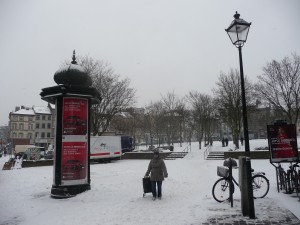
After the elevated party froze to an end, we relocated to the warm cosy house of mutual friends Tomas & Anat on rue de Moscou, recently arrived in St-Gilles from Amsterdam. After a few happy hours of catching up, listening to music, and eating potatoes, it was only a ten-minute slippery walk back to my toasty room at Sam’s, my friendly couchsurfing host.
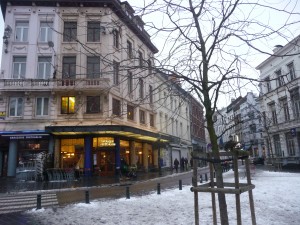
Besides a regular café, it’s of course important to know where to go for good music. I already knew Les Ateliers Claus because I played there once with Lola Montez, and headed over there through cuttingly cold winds to hear a fantastic concert by saxophone hero Peter Brötzmann and friends. The evening was opened by double bass storyteller Peter Jacquemyn. He played beautifully, making his bass sing with many different voices, all perfectly timed, the right information at the right moment. If he’d skipped the unnecessary epilogue, it’d have been perfect. Brötzmann and drummer Steve Noble played an amazing set of classic free jazz – energetic, colourful, dynamic, surprising and never letting the tension drop. Fantastic.
My first week in Brussels came to an end with the good news that I got the room. Now I’m back, after a week-and-a-half of meeting Tehrani friends at the Rotterdam Film Festival and a week of playing for dance classes. The quest for venues, musicians, friendships, and perfect coffee continues.
elephant songs: last stop utrecht
On 2 November, my drumbiker trip Elephant Songs, a musical journey from South India to the Netherlands on an old motorcycle loaded with drums, was concluded with a beautiful evening at the Utrecht theatre farm rood|noot. A full house enjoyed fantastic Indian food cooked by Sanderien, Peter, Irene, and Suzy while watching a selection of filmclips of the trip or checking out the morning pictures (now also available as a fast-forward film clip: 255 photos in 55 seconds, with music from the show at Darbast, Tehran).
In one of the many rooms of the building we then proceeded to play a concert in two parts. The first half featured different combinations of musicians Yedo Gibson (saxophones), Ayman Asfour (violin), Nizar Rohana (oud), Khaled Kaddal (guitar), Jornt Duyx (guitar, accordeon), Fabrizio Colonna (guitar), Marko Bonarius (double bass), and yours truly (drums).
oorlogsleed
3+2+2+3
The second half of the concert was a return to older Amsterdam days, when I often played duo with guitarist extraordinaire Alfredo Genovesi – for improvised or set dance shows, with the Phillip Project, as part of a larger groups, or like tonight – just the two of us, enjoying playing together.
improvisation by alfredo genovesi & robbert van hulzen
The night before we had the honour to make an appearance on the great programme Virus, which is aimed at bringing “classical music” to a younger audience. Wouldn’t have been complete without us, obviously. We played three tunes for an enthousiastic studio audience, broadcast live at the Dutch Radio 4 and the internet. Tonight’s Elephant Ensemble featured Yedo Gibson (saxophones), Jornt Duyx (guitar), Marko Bonarius (double bass), and your humble correspondent (drums).
oorlogsleed
zam-zamah
muggosphere
burootje beuk
more videos below
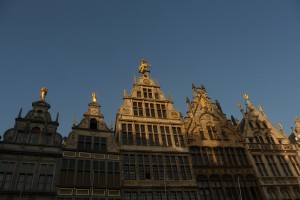
No one seemed to really care I arrived at the registration office with my Nepali plates – and that was only the beginning.
Hmm, that front wheel has some play in the bearings. What’s the official margin? None. Rear wheel – same story. The indicators, do they work? Sometimes… That’s ok, on a bike this old they’re not compulsory anyway. What about the brake light? Uhmm… You’ll fix all this, won’t you? Of course. Then all that was left was verifying that this was indeed the bike that was described in its Nepali registration papers. There was some doubt whether the bike was as old as it pretended to be, the speedometer and a few other things looking too new in the opinion of the friendly offical. But in the end it was decided that matching frame and engine numbers sufficed, and the Dutch papers would be in the mail shortly.
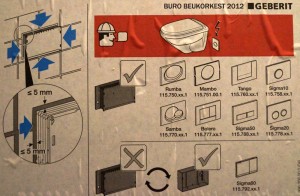
I’d found Rik online when looking for musicians in the low lands, and he kindly invited me to come join the festivities in Eindhoven. As part of the Design Week, the Beukorkest was housed in one of a row of houses still under construction. As much art gallery as concert venue, with Heet Brood‘s toasties from heaven in the garden.
After a day of playing and hanging and checking out other activities in the festival, I curled up on the short sofa in our gallery. Frozen stiff I got up before dawn and embarked on the Coldest Ride Ever to the next adventure – first rehearsals for Isabella Green with Ensemble Gending and Dyane Donck. This Elephant Songs chapter will be concluded shortly with a party at rood|noot in Utrecht – food, music, stories, films. After that, many more musical journeys, meeting local musicians and playing with them, will follow, insallah.
ensemble gending: whooosh
for more info, go to whooosh.nl and whooosh on facebook
the obscure thoughts of isabella green (trailer)
see the whole show below
past shows
| Date | City | Venue |
|---|---|---|
| 10 August
9:30pm |
boulevard festival | den bosch |
| 10 August
7:30pm |
boulevard festival | den bosch |
| 9 August
9:30pm |
boulevard festival | den bosch |
| 9 August
7:30pm |
boulevard festival | den bosch |
| 31 May
8:00pm |
de nieuwe vorst | tilburg |
| 21 February
8:30pm |
plaza futura | eindhoven |
| 16 December
3:15pm |
ostadetheater | amsterdam |
| 13 December
8:30pm |
huis aan de werf | utrecht |
| 9 December
2:00pm |
museum de pont | tilburg |
|
enkel The obscure thoughts of Isabella Green |
||
| 11 November
3:00pm |
november music @ muzerije | den bosch |
|
enkel The obscure thoughts of Isabella Green |
||
| 11 November
2:00pm |
november music @ muzerije | den bosch |
|
enkel The obscure thoughts of Isabella Green |
||
| 28 October
3:00pm |
museum van bommel van dam | venlo |
|
try-out |
||
the obscure thoughts of isabella green (full show)
homely elephant improvisations
When I visited Berlin in 2007, I lived in my yellow camper van in the Volkspark Friedrichshain amongst other mobile-home dwellers during what must have the coldest spring since the banana war. Snowstorm on 21 March. The Kastanienallee in nearby Prenzlauerberg welcomed me with its squatted cinemas, small dance studios, open source computer workshops, independent cafés, and underground venues.
Now, five years later, a lot has changed. Cheap food is still widely available, but is now washed down with latte machiatos by people wearing designer shirts. The buildings look fresh and young mothers with clean children in carrier bikes check their friends’ moods on their iphones.
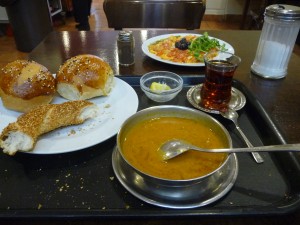
After my adventures at DIY Church Radio and the Pizza Suicide Collective, the official Elephant Songs Berlin was a rather exclusive affair. Old friend Ingrid turned up after musicians Jeremy and Oori Shalev had arrived, and she was and remained the only audience that night. The room belonging to Jeremy’s Neue Musikschule was cosy and warm, and I was excited to share the room with Tony Buck’s collection of drums from all over. After setting up and venturing out to stock up on wine and other essentials, we improvised on our drums and whistles for a most enjoyable hour.
And now, to paraphrase mister McEwan, get me out of fucking Berlin! I rode down the streets that had become my friends on my nightwalk from jazzclub Sounds the previous week, crossed the river, and then I felt the spark plug being blown out of the engine. I now know from experience that an internal combustion engine is all about compression. Ever tried to explode a blown-up paper bag that’s already got a hole in it? You hit nothing, no resistance. No explosion. Same thing happens when there’s a hole in the combustion chamber. A fix turned out to be fairly temporary, and I’m now stuck in a youth hostel in Steglitz, of all places. To be contintued. Somehow.
photos: berlin
brrrliner elephant songs: church cucumbers & suicidal pizza
And how long is your piece?
A surprising question. My drums and I had arrived at the Pizza Suicide Collective‘s Julian Percy Afterparty at Zur Möbelfabrik in trendy Prenzlauerberg expecting to find a selection of likeminded musicians to play an evening of good old-fashioned improvised music. Turned out these were all groups and projects with a clear Item they were going to Present in this squatter-chic venue. But no reason to be worried – I was very happy to find Taishi, whom I’d met earlier in the week in the DIY Church described below, willing to join me, and our Piece was a ten-minute improvisation with voice, electronics, and drums.
improvisation by taishi nagasaka & robbert van hulzen
A few days earlier, after we met during a pleasant coffeebreak around the Janowitzbrücke, Stein had invited me to his radio show DIY Church – his internet radio show that has been going for about two years now, every monday evening from 7 till 9. I brought my friend Jeremy – who not only composes and organises odd musical interventions for unsuspecting diners and the shopping public, but also plays just about any blown instrument – and with him and electronician Minuit Delacroix and vocalist / cucumber specialist Taishi Nagasaka we filled two nice hours with chatting, playing music that turned out surprisingly dubby, listening to the sounds of vegetables, sharing stories, and answering Stein’s questions.
free dub improv live at diy cucumber church
improv under a thousand spires
into central europe
Good day, sunshine! Bratislava, half past eight in the morning. A hot chili-chocolate that makes my nose run and a (strangely lemon-scented) croissant – in the sun! It’s warm enough to take off my hiking quality cardigan, the combination of sun and fresh breeze feels good on my bare arms. Is this what they call Indian summer?

It’d be fantastic if I could find our Bratislavan colleagues again, catch up and play. But I’m not very hopeful – I think I found their studio last night, and, like many things here, it all looked a bit more polished and upmarket than it used to. I’m not saying that they couldn’t have gone with that in the past eight years, but they may have also taken up residence somewhere else. If they’re even still here.
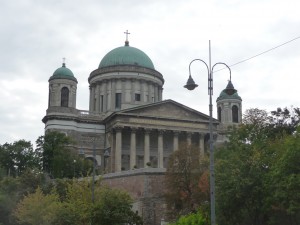
After endless suburbs and a sign pointing to the Napkollektor (sounds like a dream job, wonder if they’re hiring?), I came by a campsite that rung vague memory bells – did I stay there with my highschool class in our final year, a few lifetimes ago? A great week filled with museums, quests for vegan food, missing my first girlfriend, wandering around town, and the first time I tried my luck at firebreathing – inspired by the effect of spitting vodka into the campfire, a classmate and I got a few bottles of petroleum and became the stars of the final evening.
The Danube’s famous bend to the west started via the picturesque (and slightly Efteling) towns of Szentendre (St Andrew) and Visegrád. Beautiful road through forests along the river, and lots of bikes. We wave at each other enthousiastically. Lots of Harleys like before, and all your regular plastic bikes that I wouldn’t be able to identify to save my life.
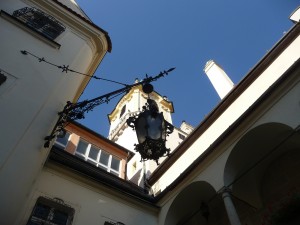
Straight west the last 100 km through Slovakian fields. Squinting into the sun makes sleepy eventually, but the golden light was beautiful and comfortable.
Though the sun hadn’t even set yet, it was getting dark as I rode into Bratislava. I simply following the signs for “Centrum” – no idea where to go, as usual. GPS is overrated. (I admit Budapest wasn’t much fun, but that was more related to the bike’s engine either stalling or racing every time I stopped. Got to get in touch with Liz & Phil again, I think.) Found the most extremely factory-like sleeping arrangement so far, and ended the day sampling the local spirits in a bar playing pleasantly loud metal.
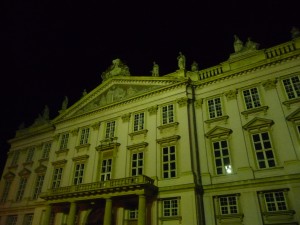
photos: beograd
wisdom & poetry
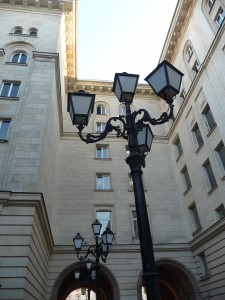
In-bowl taps in the toilets replaced with paper, church bells instead of azaan, and on the road to Sofia every other kilometre a stoned-looking woman who forgot to put her clothes on, advertising things as diverse as hotel rooms, soft drinks, and hunting rifles.
Riding into Bulgaria’s capital Sofia was a strange déja-vu. I’ve been told its grandiose neo-classical style is typical for the communist era (the city was bombed badly during WW II); to me it first of all looks European. Familiar brands of cars (and the odd Lada and odder Trabant) glide through the streets, gallantly stopping for anyone who so much as looks at a zebra crossing. I’ve reached a different part of the world. (The taxis are still yellow, though. Since when have there been yellow taxis? Iran?)
Even the weather has changed – on my way from Plovdiv to Sofia the forests were turning yellow and the evenings are chilly now. Summer is on its way out, the exotic part of my trip is over, from now on everything is much more familiar.
All that said, I’m looking forward to the different flavours of Europe I’ll encounter on my way up. So far, one surprising feature of the Bulgarians is their use of the Indian headshake for “yes”. And that while I’d just gotten used to the Iranian and Turkish meaning of a very similar gesture, a quick shake combined with an irritated frown, meaning “I beg your pardon, say again?” The throwing-back of the head still throws me off – with or without a sharp tongue-click, this gesture, so close to what I understand as “yes”, means “no”. To add to this happy diversity, the same gesture in India means “I beg your pardon, say again?”. Still following? All I’m saying is that Milan Kundera’s theory of how gestures use people to express themselves, however charming, might not be the full story after all.
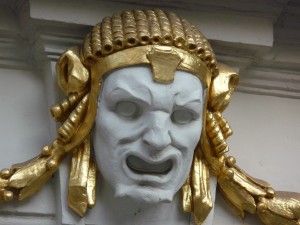
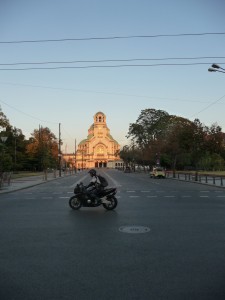

| I spent a few pleasant days wandering around Sofia’s cobblestoned centre. Found some CDs by Theodosii Spassov and finally an interesting book again (Emine Sevgi Özdamar’s The Bridge of the Golden Horn finished long ago), Eco’s The Prague Cemetary. Should be a good preparation for my journey through the dark heart of Europe. But first I’ll have another go at finding the frenzied rhythms in 13/9 that I looked for in Sofia in vain. Belgrade, Serbia, here I come! |
istanbuli nights
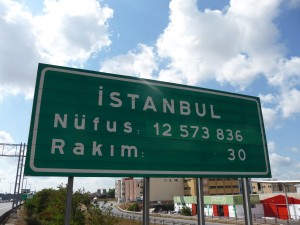
Upon my arrival in İstanbul from Safranbolu, singer Sumru and yours truly met at the Kadiköy boat station. Lots of tea (what else), and we chatted and walked around and watched the sunset over the famous skyline of Sultanahmet across the Bosphorus – in Europe! Sumru found me a room in percussionist Burhan’s house in Mecidiyeköy, also on the other side. More offices and suits than tourists, but enough tea shops and the most important thing of all: fantastic coffee. A bike mechanic and a shop with a friendly cat-loving owner were my neighbours.
kadiköy by night * music by sumru ağıryürüyen, anıl eraslan, and robbert van hulzen

Many musicians had left for summer, and a lot of venues were closed – but those remaining were eager and enthousiastic and we had happy, sweaty sessions in shorts and summer dresses. (Enjoy the post, including video, on the Gitarcafé jam with Sumru and Anıl; recordings of the shows at Kooperatif and Nina’s will be up shortly – come back or subscribe to new posts.)
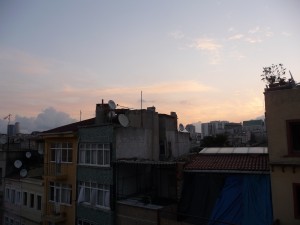
Gigs all done. Ramazan is over, crossing the bridge is no longer free but sets off irritating alarms. Time to move on, after almost four hazy weeks. İ rode out of İstanbul after a few last espressi at Nero’s and managed to leave the highway without triggering too many toll sirens; onto the İstanbul Caddesi to Edirne through green hills & prefab Tim Burton villages. Called it a day in Pınarhısar; good çorba and pide. After that I thought İ’d sleep but the music at the gypsy-or-whatever wedding-or-whatever next door has too many cool grooves. Half awake till morning azaan – Lee Perry style, endlessly bouncing between high buildings, the dogs joining in en masse but soon abandoning their efforts to keep up. I really should get some sleep.
songs of beyoğlu
Besides the most enjoyable improvised sessions I took part in in Istanbul (with Sumru and Anıl, with various musicians on the Elephant Songs night in Kooperatif on 10 August, and upcoming on 20 August in jazzclub Nina – material of those last two events coming up, check back or subscribe), I was very lucky to have a few cosy evenings at the studio of streetfolk legends Kara Güneş. I had fantastic cheese, fell in love with the santoor, and had great chats with many wonderful people.With one of their members, multi-instrumentalist Özgür, and cellist Duygu Demir, we played with and improvised on songs, grooves, and ideas we all brought.
elephant songs: nice to meet you
One of the aims of my trip elephant songs is meeting musicians in places I travel through on my journey from South India to Amsterdam. As I explained in the five-minute-film I made to introduce the project, when collaborating with people in this way, playing together at such short notice, it is not about coordinating big elaborate forms, complex themes, or cleverly schemed developments. All of those may occur, but in spontaneous ways and as individual voices. We’re trying to have a conversation, exchange thoughts, not stage a classic play.
On most previous occasions, we did work out a structure, some themes, a raga, groove, or mood to inspire and sometimes guide us, maybe just give us a starting point. In Istanbul on the other hand, I’m meeting a lot of musicians who are into playing without any arrangements at all – like I used to do a lot in Amsterdam. Amongst the most versatile and imaginative musicians I met were cellist Anıl Eraslan and vocalist Sumru Ağıryürüyen. I had the good fortune of spending an afternoon with them at the Gitar Cafe in Kadiköy, across the high scary bridge, on the Asian side of the Bosphorus. (Yes, I live in Europe these days.)
Sumru and Anıl play together more often, despite the fact that Anıl is based in Strasbourg at the moment. They have a fantastic album called Sert Sessizler / Harsh Consonants out on Baykuş Music; check also their video – great textures, samples, whistling, voice, cello in all the ways you’d imagine and a few more. For the album, it seems the editing room is as much an instrument as the recorded events, reminiscent in methodology (though not necessarily in sound) of Henry Cow‘s Unrest.
In elephant songs, I generally try to avoid working with existing combinations. Of course musicians often know each other – I meet them through each other after all – but playing with a new combation of people greatly reduces the risk of people playing their usual stuff, with my drums as just an extra voice that may not actually make such a big difference. I knew Anıl and Sumru work together more often (hadn’t heard Sert Sessizler yet though), but the way we interacted felt totally three-way. I wasn’t playing with a duo, this was three people meeting on new ground – of course all bringing our own preferences and tricks, our histories and our dreams.
When I played with a band called Schors a few lifetimes ago, we used to play “singles”: an improvisation of three to four minutes, one idea, concise and, in one way or another, catchy. I’ve been using that approach with many improvisers since, and this is what happened when we did a version with the 8 August trio.
safranbolu songs
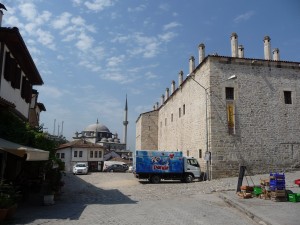

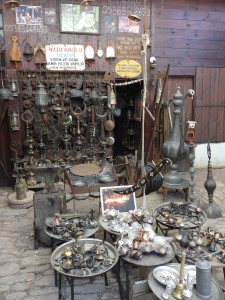
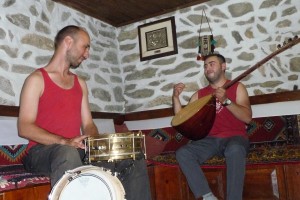 |
off with its head – again?!?
Riding through the hills around Kaleybar, in South Azerbayjan in the north of Iran, the hole-in-the-head-problem had clearly returned. The weld in the engine head, done in Tehran just a few weeks ago, had holes in various places. Uphill the bike was wheezing like an asthmatic donkey and demonstrated matching torque – a great way to burn a set of clutch plates. Starting was next to impossible, the engine simply didn’t have enough compression. Fortunately my new friend Masoud, taxi driver and tour guide, knew a mechanic in Abdel Razaq, 50 kilometres down the road to Jolfa, who would certainly be able to solve my problem.
The road was beautiful. Not much traffic, so I puffed my way through rolling hills and rocky mountains unbothered. I managed to attach the camera to my tankbag – a move of debatable merit as the video portrays me as a geriatric cripple who’s afraid of everything that is not flat and straight. You lose the joy of riding a little if anything that requires a bit of pick-up has to be done in first gear.
the road between kaleybar and abdel razaq * with original music
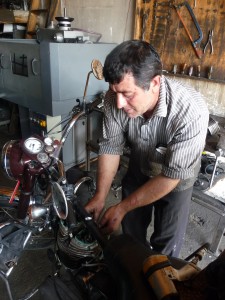
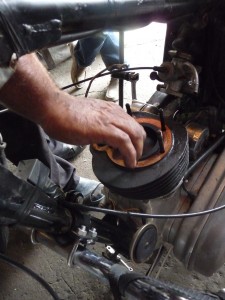
Unfortunately, by the time the engine was in pieces, the electricity was gone. A mysterious phone call promised its return at 3 pm. It was 11:30 in the morning. No problem – my longer-than-planned stay in Kaleybar had eaten my money, so I hitch-hiked the 35 km to the nearest village with a bank. The journey didn’t take long, these people drive like maniacs. In a good way.
In the bank I was of course told they couldn’t change money, I’d have to go to Tabriz, a day’s travel away. I just hung out a bit, while more and more people gathered. Eventually I got what I needed, at an incredible exchange rate.
Sitting in the shade of a tree eating a lunch of bad crisps and worse cakes, I realised once again how happy I was, how easy everything actually was, or rather how perfectly allright. And how special. Now all I need to do is find out how to bring this attitude to bargaining with rickshaw drivers, asking directions, and thinking about my future.
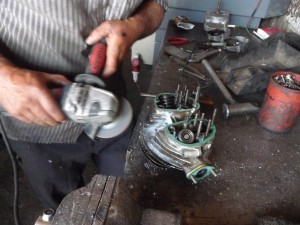
When everything was done, I started the engine with a satisfying roar and took off, waved goodbye by an enormous crowd of well-wishers that had materialised over the previous fifteen minutes. From 0 to 90 km/h in 100 metres! Or so it seemed. I don’t think the bike ever performed that well, except maybe in the Golden Days of Highway 76 in Rajasthan, last November, on my trip from Nepal to South India. Another reminder of those days were the herds of cows and goats on their way home.
I turned left when I met the Aras river, at Eskanlu, the golden late afternoon light casting my shadow ahead of me. The river, which forms the border with Azerbayjan and, later on, Armenia, grew to the width of a small lake while I was in a tunnel, and kept changing appearance after that. I was surprised how fast it flows.
Empty villages on the north bank in war-stricken Azerbayjan curiously fit in the landscape, as did the rusty barbed wire fence that lined long sections of the river.
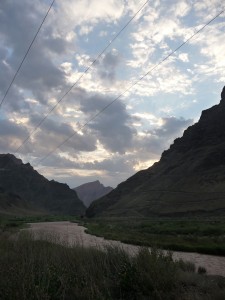
Another reason not to stop was that the beauty of the sky also indicated the coming darkness. Coming around a bend a little later, the sky was on fire – and then the sun dropped behind the horizon.
The road, severely damaged in places and covered with gravel in others, snaked through the mountains and it was very windy. While the sun disappeared, a thunderstorm started. At first, the lightning was horizontal, high up in the sky, then the lines, looking like cracks in an old wall also connected to the ground. No sound of thunder though, so it was far way – at least for now. A sign told me I had 25 kilometres to go, reminding me of how long the 25 km through rain and lightning in Lahore had felt – the cold, the darkness, the slippery road, the fallen trees on the road, the crash. Sometimes the road led to the right of the dark clouds, west toward the bit of light that wasn’t gone yet. At other times, the road aimed straight towards the streaky curtains of rain, making me wonder if I’d get soaked and maybe worse after all. Then, unexpectedly, I rode into a part of Jolfa that reminded me of shopping centres in mid-sized European dormitory towns – lots of square buildings selling poor quality versions of anything you could think of. I easily found the hotel I was looking for, and took my lugguge inside while the clouds burst into big tepid drops and the last light disappeared. I finished the day with two omelets (with tomato, as is the norm) and several cups of tea, chatting with the friendly proprietor and several Balochi Pakistanis that were staying there.
off with its head!
On my way from Esfahan to Tehran I noticed a New Sound in my bike.
Anyone who’s ever owned a mature bicycle knows what I’m talking about. In Zen and the Art of Motorcycle Maintenance, Robert M Pirsig describes how the engine of his “cycle” sounds like there’s a hand of loose change rolling around in it, but how he immediately recognises it when something is out of the ordinary. Your machine can make all the sounds in the world and may sound dreadful to others, but you know the way it sounds – if anything is different, you pay attention.
In this particular case, I first thought of the words of mechanic Farooq in Katmandu: “It will go away.” And it did: after a little while, the loud “clack” that accompanied every stroke of the engine disappeared. And came back a little while later.
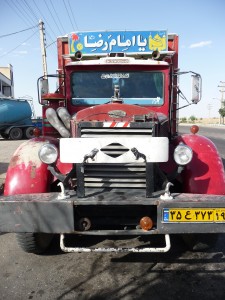
In Tehran, a friend took me to a mechanic that he hoped would know what to do with my bike – not too obvious in a country where any bike over 250 cc requires a hard-to-get permit. However, the ’80s Goldwing in the entrance of Uncle Ali’s workshop inspired trust, and the two Harleys he had stored there increased that trust, as did his enthousiasm. After trying to think of a way to fix the bike without opening the engine, he decided that the head would have to come off after all, and be sent to his favourite Armenian to rework the spark plug hole. After we took the head off we found out that the Armenian magician had left town for a few days, so the bike lived in Ali’s shop for what turned into a week before the head specialist returned.

On my way from Meshgin Shahr to Kaleybar the week after, I noticed a New Sound in my bike.
elephant songs: ba1pa, on one leg
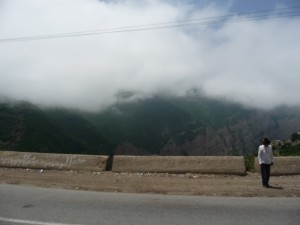
I liked that about my Iranian friends – their politeness lies in hospitality and courteousness, while they don’t mind giving criticism, or receiving it. Apparently there was something wrong with the bademjan, the aubergine. My mirza ghasemi, roasted aubergine mixed with copious amounts of garlic, was delicious as usual. The proprietress of the eatery acknowledged the complaint, and we said goodbye in friendship.
Mazandaran food would be a happy memory when I got further up north, towards the Azerbaijani border. Do you have any vegetables? No. We are Azeri. We eat meat. Baluchistan food crisis all over again.
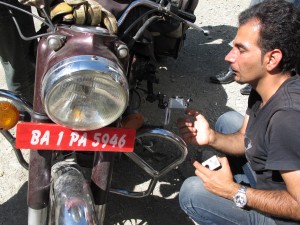 |
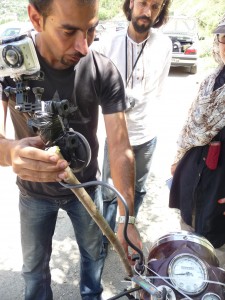 |
|
attaching the camera to the bike * left photo by golboo fiuze
|
|
After our seaside resort days in Neshta Rud we were on our way to a village in the mountains, where Tehrani musician Majjid Rahnama and yours truly were planning to play a concert. Reza Fahramand was going to film it all, hoping to bring the result to film festivals around the world. However, after lunch it was decided that our planned destination was too far away; the village of Jannat Roudbar was considered a great alternative. A good choice, it turned out, especially after a quick musical break on the side of the road unexpectedly took much longer: a car screeched to a halt and out tumbled a very drunk driver and his proud son. Majjid and I ended up accompanying the father on an endless, narrative folk song with an infectiously melodic little chorus. When this suprise meeting was over and my new friend had kissed me full on the lips in goodbye (to great hilarity of my filming companions), we rode on to Jannat Roudbar. We were shown into our comfortable rooms on the second (and top) floor of the house of a lovely couple. The man was concerned about the safety of my bike and insisted on covering it, so caringly we hid it (though of course everyone had seen us enter the place). Over oily, hot, delicious omelet and strong black tea in the lovely village tea house that night I was very happy with our new home-for-a-few-days.
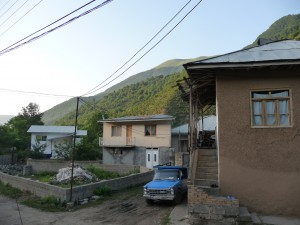
We spent the next days hanging out, playing in the teahouse, having more tea and omelets, chatting, smoking water pipes. We considered a number of locations for the show. The cemetery, an interesting idea of Reza’s, didn’t work out for various reasons, the disapproval of the local mullah an important one among them. We eventually decided on the square high up on the hill in the village, a more open space than the lower square which was full of shops and trees and other things. A stage was constructed and people gathered. We performed five tunes, in which Majjid played seven different instruments. We didn’t talk before (didn’t even speak each other’s languages), didn’t prepare anything specific, we just sat down as two musicians and played. We played the way we are, relying on each other because we both know music, singing together without words.
beach fun
After finishing the successful shows in Tehran, I had planned to ride through the Alamut Valley to Qazvin, to visit the castles of the Assassins on the way. Then on to Tabriz, and up to Armenia.
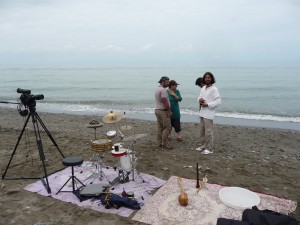
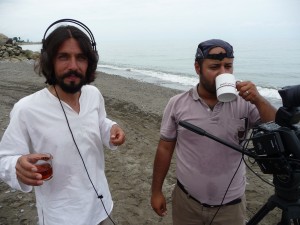
And wet. For some reason (possibly the fact that a large part of their country is made of dry sand and gravel, as I experienced earlier), Iranians love the wetness of the north. “Just like where you’re from!” – as if that was a recommendation.
After the amazing Karaj-Chalus road, we rode up the coast for a while. Before heading into the mountains, we stayed at a beach house in Nashtarud for a couple of nights, swimming in the (cold!) waves and jamming on the beach. In the rain, of course.
elephant songs: pil ahang at darbast
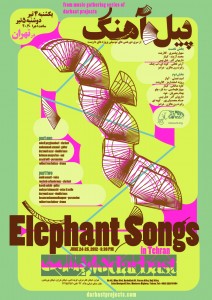
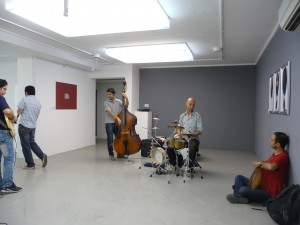
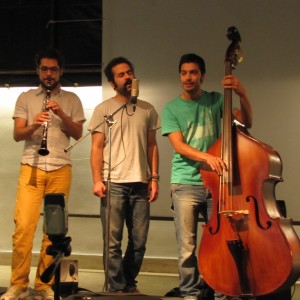

After a week of intense rehearsal, we played two sold out nights (apparently all tickets went in half a day) for very happy audiences.
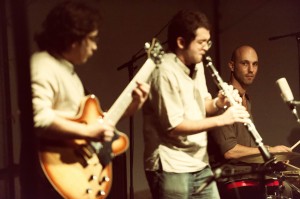
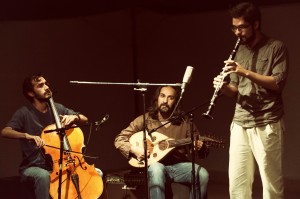
elephant songs at parkingallery, tehran

In the summer of 1998, Amirali Ghasemi started the Parkingallery, an independent project space in a former garage in the north of Tehran (expanded in 2002 with an online gallery). One good Friday, at the opening of Amir Bastan‘s Worn Out Mirrors (Friday is Opening Day in Tehran), fellow percussionist Arash Lotfi informed me that we would perform in the space that coming Sunday. We asked oud player Kaveh Kamjou to join us, and, surrounded by Amir’s rorschach-art, we played an evening of improvisational music to a, given the short notice and no advertisement, surprsingly large crowd.
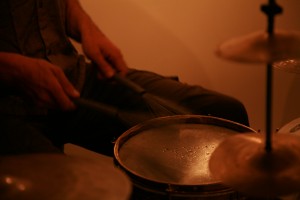
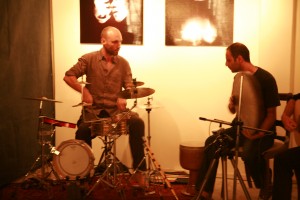
One of the pieces was a percussion duo, featuring Arash on the lab chang, a Persian mouth harp.
kodum guri hasti?
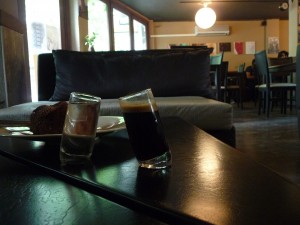
Kodum guri hasti? Where the hell have you been? Riding around the desert for weeks, with burnt lips and sand up my nose, that’s where I’ve been. Very happy to be in a city again. Busy streets, a different smell on every corner – jasmin, kebabs, sewage, fresh bread, old sweat.
Kodum guri hasti? The expression comes to mind often when trying to navigate the city too. The literal translation is beautiful: which grave are you in? Apparently it’s quite rude. And so is the traffic – while in pedestrian life you may spend ten minutes waiting for each other to pass through a door, once they’re in their cars, Iranians are ruthless. Being in Tehran involves many hours of fighting through and getting lost in a vast network of highways – life doesn’t get much more urban than that. Especially enjoyable when driven around, Kurdish music drowning out the rattle of the airconditioning, by grinning Aylar, throwing the wheel around and dancing on the pedals like a ballerina driving a rollercoaster.
Just like the cafes move comfortably between Tom Waits and Alireza Ghorbani, historical and contemporary culture from all over the world inform cosmopolitan Iranian culture. At least at my, possibly naïve, first sight, there doesn’t seem to be a struggle for domination – whatever is useful, is used. Bad news for authenticist purists as well as for those who think western pop is the answer to everything, good news for all of us who just want to create and enjoy an interesting and interconnected life without worrying too much about the ideology of its backgrounds. And despite obvious problems, cultural life is diverse and thriving in Tehran – cafés, galleries, restaurants, parties. On one of my first days in the city, artist and independent curator Amirali Ghasemi whirlwinded me through a variety of North Tehrani galleries and then got me into an officially sold-out concert of Tehrani folk-fusion heroes Pallett.
Kodum guri hasti? Wherever I was, it wasn’t on a concert stage and I’ve been missing it. I guess it’s what happens when you decide to travel from South Asia to North West Europe on an ancient tractor, these things tend to take time. But I’m happy to have some playing opportunities here again. I had the joy to play a nice concert at Amirali’s Parkingallery last Sunday (videos will be up soon), and am currently preparing two evenings of music at Darbast at the Mohsen Gallery next week, involving the Pallettis and Soheil from the video below, among others. Of the many informal playing sessions at people’s homes, the one at the house of musician & film composer Ali Samadpour and visual artist Negar Farajiani was a particularly enjoyable example – a great night of eating, playing, drinking, talking.
dinner music meeting with ali samadpour & family, amirali ghasemi, soheil peyghambari, martin shamoonpour, aida khorsandi, and robbert van hulzen (4 june)
elephant songs in lahore – multiple contacts
On Thursday 26 April, a fantastic selection of musicians from the Lahore rock and fusion scene joined elephant songs for a great show at True Brew Studios, Lahore. The evening was recorded by Jamal Rahman and Fatima Shah, and later mixed by Floris van Bergeijk. Jawad Shahid and his crew filmed the event.
We started the evening with a group of musicians you may remember from the music meeting on the rooftop of my hotel a few weeks earlier: maestro Akmal Qadri and his son Ali Abbas on bansuri, Kashif Ali Dani on tabla, and myself on drums – joined for the occasion by guitarist Danish Khwaja of Poor Rich Boy fame.
zam-zamah
raag hans dhun
And now for something completely different: a free rock trio featuring Japanese synth wizard Masaki Okamoto (with his new synth) and riff master Danish Khwaja.
here’s johnny
With rockstar bass player Sameer Ahmed of co-Ven fame and electric sitarist Jamil Rakae we played a beautiful jazzy world set, for lack of a better term. (Can someone with better pr skills help me out here?) Video of this and the other tracks will be up shortly, check back or subscribe to updates. For the time being, enjoy the audio, as stream or download.
rocks?
Here’s a glimpse of what we finished the show with – featuring Danish Khwaja, Sameer Ahmad, Kami Paul, Raavail Sattar, and yours truly.
rooftop meeting and show tonight
On Sunday 15 April, I was visited by Akmal Qadri and his son Nazar Abbas and tabla player Kashif Ali Dani. We enjoyed tea and music on the pleasant rooftop of Sajjad Hussain’s Lahore Backpackers.
I met Akmal and friends again yesterday, when we rehearsed for the show at Truebrew Studios tonight, set up by Jamal Rahman and Raavail Sattar. It’ll be a get together of musicians and friends that I was fortunate to meet here in Lahore. We’ll play in four different line-ups – and whichever other configurations happen. The musicians playing tonight are Jamal Rahman, Sameer Ahmad, Rakae Jamil, Masaki Okamoto, Danish Khawaja, Kami Paul, Fahad Khan, Akmal Qadri, Nazar Abbas, Kashif Ali Dani, and myself.
jilebi chronicles
Gooey or crispy, that’s the debate – or so I learnt from reading Kamila Shamsie’s Broken Verses. Either way, I was very surprised to find them here in Pakistan: jilebis! A deep fried sugar concoction that melts in your mouth, and on your fingers, which I believed to be South Indian. Turns out to rather be South Asian.
Tonight’s jilebis were the conclusion of an unexpected night out – I went over to Faheem’s house, a fantastic singer I knew from when he worked on a show that old friends of mine were involved in too. Just wanted to say hello, see if here’d be a chance of doing something music-related while I’m here.
After meeting his lovely family, we left the house and soon I found myself sitting around a table in a dark park (no electricity) with Faheem and five of his friends. All of their lives have taken them to very different places (also geographically, one of them has lived in Toronto for 35 years) but still those who are around get together in the park every night, to walk, drink tea, catch up. Faheem met them when they came to a concert of his and started talking to him afterwards.
We finished our tea and went for dinner at a grill restaurant. Where they managed to order salad and two different kinds of dal that had really almost no very recognisable chicken in it. A relief for my vegetarian sensibilities.
Dinner turned out to be only the second item on tonight’s programme; afterwards, we needed a decent dessert. Jilebis. And not just any jilebis, but the best in town, so we made our way over there.
They were delicious. And, this being Pakistan which means hospitality doesn’t stop, we concluded this very pleasant evening with green tea at the house of one of the friends. Well after midnight, and after various slightly concerned text messages from hotel boss Sajjad (the type he starts sending every night around 11, if I’m not home yet), we said our warm goodbyes and I rode home with a big happy smile on my face.
peeru’s café
The first time I went to Peeru’s Café, my landlord Sajjad of Lahore Backpackers insisted I take a rickshaw – “for security”. When I told my driver my destination, well-known for its qawwali performances, he proudly announced he was a qawwal himself and sang all 25 kilometres of the way there. Welcome to Pakistan.
Reaching the place, I was a little surprised by the high, barb-wired fence with the steel gate and armed guards – not just your regular guys dozing in chairs with shotguns in their laps, but uniformed men in bulletproof vests and complex-looking weapons – all dull black angular metal instead of the usual simple steel barrel on a wooden handle. After my bag and I were screened and searched and declared acceptable, I was shown into the compound – a beautiful, quiet, and relaxed place that I later found to be much bigger than what I saw just then: a glass house where juices were made, a small stage, and a number of tables where waiters served food and drinks that were presumably prepared in the building in the back. Only later I learnt that Peeru’s had been attacked several times in the past – with bombs and arson, terrorists attempted, in vain, to disturb and discourage the lively cultural scene promoted there.
When I was preparing my visit to Lahore, Pakistan, my invaluable friend Neil van der Linden had put me in touch with the Peerzada family, who run Peeru’s Café and the Rafi Peer Theatre Group. Peeru’s is part of a compound that houses the café-restaurant, an auditorium, various artist-run arts and crafts shops, the puppetry museum, and the offices of the RPTG. While I was still in India, Mr Faizaan Peerzada kindly helped me obtain my visa for Pakistan, and invited me to come over to discuss what we could mean to each other as soon as I reached Lahore. Meanwhile, playing with Maarten Visser and Keith Peters at the Global Music Festival in Madras, India, I met Sam Mills and Susheela Rahman, who adviced met to get in touch with one Hassan Qureshi in Lahore. Hassan responded enthusiastically, and mentioned his family’s auditorium and their many musician friends. We agreed to meet and talk about possibilities for elephant songs – and Hassan turned out to be married to one of the Peerzada daughters and having an important function in the Rafi Peer organisation. The world is small. Like everywhere.
After meeting them at Peeru’s that first night, the brothers Faizaan and Saadaan took me back to their home right for a lovely evening of chats and drinks and brainstorming about what we could do during my time in Lahore. I was excited to hear them suggest I’d play with the famous dhol players, the sufis Goonga and Mithu Sain. We discussed ideas and set some things in motion and then went back to Peeru’s for dinner – Punjabi food (the cuisine that is served in most so-called Indian restaurants in the west) of such a refined quality that it redefined my opinion on the north-subcontinental kitchen. Contrary to my earlier judgments, I think I actually like it.
The following days many things happened. Sajjad took me around Lahore, showing me the old town and some sufi shrines, including lots of qawwali, and also the Badshahi Mosque. I wandered around a lot, went back for juices at Hafez’s, had almost-vegetarian biryani for lunch. For dinner I often went for the fantastically spicy lentil-and-eggs concoctions served in a small place close to my room, usually dark because of the frequent power cuts (one hour on, one hour off). The boy who cleaned up usually brought me a candle so I could still read my book on the Great Game. I met many more musicians and I had the great honour of playing with Goonga and Mithu Sain on several occasions, including, interestingly, a French cultural evening at LUMS University. (A post with clips of several of these collaborations is coming up, check back or subscribe.)
On Saturday 7 April I was at Peeru’s again. I’d brought my drums, and played for two hours with maestro Mian Meeri and his qawwali troupe. I’m looking forward to what’s next. Apparently, there’s something coming up with the Sain brothers and UK dhol sensation Rani Taj. And I’m working on putting together a dedicated elephant songs show with a lot of different local musicians here in Lahore. Stay tuned.
takatak
Takatak is the onomatopeic (or, as the Germans in an unexpected but most appreciated fit of romance put it, onomatopoetic) name for a dish consisting mainly, if I’m not mistaken, of chopped up goat’s testicles. All over the old town of Lahore you can hear the sound of chopping knives on metal plates, takatak takatak.
Takatak is also the name of Zain Peerzada‘s trash metal band. On Sunday 1 April, they played at the Guitar School in the chique Lahori suburb Defence. In a room the size of an ambitious living room at the top floor of the Guitar School, some thirty or forty music lovers gathered. Shorts, uncovered heads, beards, metal shirts, kurtas, Urdu, and English were happily mixing, showing that there is an alternative to the polarised views of most (western) media.
I missed most of Keeray Makoray’s show, though I did notice the singer has a great voice and likes Pearl Jam’s Eddie Vedder. And here, like in India, George Michael’s Careless Whispers enjoys a continuing popularity, for reasons that are a little beyond me.
Takatak was fantastic – tight, fast, and loud like a metal band should be, and with enough unexpected turns to keep me captivated from beginning till end. Unfortunately I’ll miss their next show – a free fight gala, where men in cages beat each other to pulp to the sounds of crunching guitars and growling vocals.
lahore!
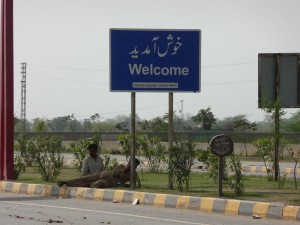 Lahore, Pakistan! I’m in the next country of my road trip, one closer to Holland. Eleven to go :-)
Lahore, Pakistan! I’m in the next country of my road trip, one closer to Holland. Eleven to go :-)
The Wagah border, the only overland border between India and Pakistan, was surprisingly quiet. On the Indian side, I was held up while a number of easygoing Sikh officials went through the paperwork, complaining about and pseudo-apologising for how many forms and ledgers had to be satisfied. When it was all done, an even higher official came and made me open all seven bags on my bike, signed the form to end all forms, and wished me a good journey.
The Pakistani soldier on the other side welcomed me with a firm handshake, and the carnet was quickly processed in a large and well organised hall that was just as empty as the one on the Indian side. The luggage check consisted of the question whether I was carrying any alcoholic beverages, and, after a few more handshakes, I rode out of the border area and had a tea at the roadside stalls behind it. An old man with a long grey-black beard and a kefiyeh draped over his head looked at me curiously and then smiled, shyly. More friendly and investigating looks, more handshakes, and lots of small talk with gestures and guesses rather than words.
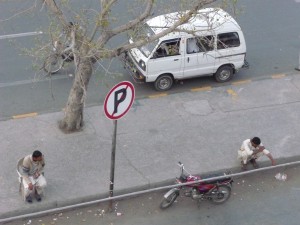 Lahore feels comfortable. Wide streets, unagressive traffic with not many horns at all, and it’s so clean!
Lahore feels comfortable. Wide streets, unagressive traffic with not many horns at all, and it’s so clean!
It was well past lunchtime by the time I’d found my hotel and checked in. I went for a stroll, walked by some delicious-smelling kebab stands and eventually settled for a fastfood joint that had tables all over the pavement, with people leisurely enjoying juices and burgers and each others company. A few arts students with poster tubes were chatting over a big cardboard model of joined geometrical shapes. I shook hands and then shared a table with a clean shaven man with bouncy henna-red hair and a subtle line of kohl around his eyes. Tried ordering vegeterian food without meat. A sandwich with only egg, please. Chicken? No, just egg. Chicken. No please, no chicken, no meat. Burger? This is where my new friend – who didn’t speak any more English than the waiter – interfered.
It was great just sitting there on the side of the street, relatively unnoticed, and watch the world go by. It was a varied world, with distinct differences between dress style, beards, skull caps, women’s head scarves, etc, I imagine based on geographical origin, tribe, economic background, and so on. Tall, big-bellied men with black or grey beards, men with henna-red beards, clean-shaven ones in jeans and t-shirts, and many men, bearded or not, in salwar kameez (long shirt and baggy trousers). Women mostly have their heads covered with colourful shawls like a saw in Rajasthan and the Indian Punjab, burqas, or other scarves. Looking forward to learn a little more about all these different people and starting to be able to guess people’s origins.
I washed down the sandwich with a cold and tasty banana shake, said goodbye, and resumed my wanderings / wonderings. Khuda hafiz.
the thar desert: balesar to bikaner
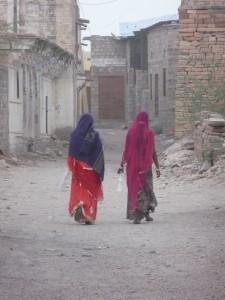 After taking my morning pictures, I knocked on a few doors, hoping to find someone to unlock the door to my bike. Everyone I talked to seemed to understand what I wanted, and then disappeared without anything happening. Eventually another hotel guest talked to some of the people, and the guy who was in charge turned up, fully clothed, washed, and combed – not just recently awoken at all. He quickly left and returned with a large blue bucket, and went into my room. After some more shouting from the other guy, this confusion was cleared up too, my bike was liberated, and I could leave this charming little town called Balesar.
After taking my morning pictures, I knocked on a few doors, hoping to find someone to unlock the door to my bike. Everyone I talked to seemed to understand what I wanted, and then disappeared without anything happening. Eventually another hotel guest talked to some of the people, and the guy who was in charge turned up, fully clothed, washed, and combed – not just recently awoken at all. He quickly left and returned with a large blue bucket, and went into my room. After some more shouting from the other guy, this confusion was cleared up too, my bike was liberated, and I could leave this charming little town called Balesar.
The landscape changed every kilometre. It’s amazing how many faces the desert has – of course there’s the dry sand dunes that I imagined, but it’s so much more alive too, sometimes making me wonder if this actually was the desert. I guess it all comes down to how stuck you are in your definitions.
A long tea break with my book and several cups of tea and a lot of water on a charpoy in the sun warmed me up after going against the strong and cold wind for a few hours. This desert air is too dry to retain any temperature – freezing until the sun is out, and then it burns.
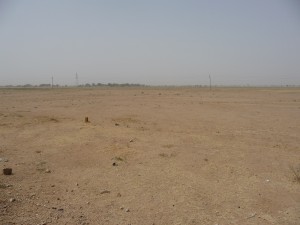 After Bap, the landscape opened up into endless fields of rocky sand with a little vegetation. Here and there enormous waterbuffalo and skinny cows were munching on the leathery bushes.
After Bap, the landscape opened up into endless fields of rocky sand with a little vegetation. Here and there enormous waterbuffalo and skinny cows were munching on the leathery bushes.
Takes some getting used to, all these animals on and right next to the road.
Dogs are smart: they react to horns and generally take the shortest way out. Cows are too thick to react to anything until you’re very close, then they panic and trip over their own legs. Goats are too arrogant to react to anything, but too clever to get run over. Sheep get very nervous when separated from other sheep. A specific, and very tricky, kind is mainly found near road crossings in villages – men with big bellies who cross without looking. The extent to which they lean backwards is an indication of how important they are, and is inversely proportional to the likeliness of them moving out of the way for traffic. This, like so many others, is the time for pragmatism rather than principled idealism – right or wrong, running into one of these people would be a major hassle so I give in without further thought.
In these open fields, the wind is no longer cold but even stronger and more head-on. Every oncoming truck brings a shockwave – best reacted to by covering your mouth and gripping the bike with your thighs, rather than squeezing the handle bars and locking arms and shoulders. What was it that Ewan McGregor said? Loose hands? Open hands?
I found a nice room in desert town Bikaner. Headed out for some food after dark, and after kindly turning down an indecent proposal from a guy on a bike, I found good noodles and a lemon soda seller who produced the most amazingly loud squeek with the gas from the bottles he opened. Walking back with a full belly, the guy on the bike found me again, following me, sometimes stopping on the other side of the street, sometimes overtaking me and coming back. When I eventually asked him what he wanted, he declared he was gay. I told him I wasn’t interested, wished him good luck, and we parted with a handshake. Until that surprisingly friendly turnt of events, it wasn’t exactly threatening, but certainly uncomfortable. And it made me think about how often this must happen to women, who may not even always be sure they can probably take on whoever attacks them, simply in terms of physical strength.
I’ve been in this desert for a while now. Lets try and get into the Punjab tomorrow.
playing temple music in india’s deep south
Spent the best part of my last night in Madras stuffing my life into the few (…) bags I can take on the bike – I always end up packing at night, 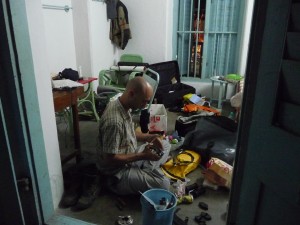 |
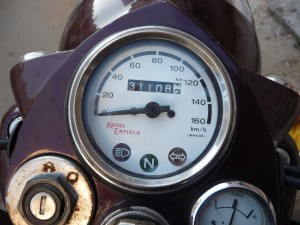
I never made it to the beach – in Mamallapuram I’d told myself I’d go in Auroville, but once I arrived the bike’s needs seemed to be more important than my beach boy aspirations and I ended up in a mechanic’s sidewalk-garage for the better part of the afternoon. He charged me the princely sum of 100 Indian rupees to play with the idle screw on the carburettor a little, telling me the contact breaker points were ok. While I’m still not sure of the latter, the bike does run better now. It’s funny, I’ll happily tear apart a gearbox and put it back together perfectly, but the precision work of tuning the bike by turning a few screws a couple of degrees is fully over my head. I guess I’ll learn – I guess I’ll have to – but for now I was happy watching the mechanic’s practiced fingers do the job, meanwhile admiring the bike he was restoring and chatting to a Frenchman who’d been in Pondy for 20 years and owned four Taurus Enfields, the diesel model. An amazing 6 horsepower bike – the upside is it runs forever on a drop of decommissioned cooking oil.
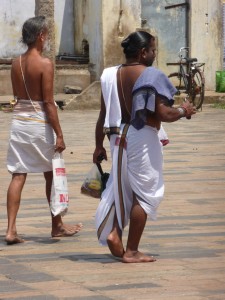
In Chidambaram, I had a refreshingly touristic stop: after tea and a bottle of water, I visited the Thillai Nataraja Temple, leaving the bike with all its luggage in the care of the proprietor of the teastall.
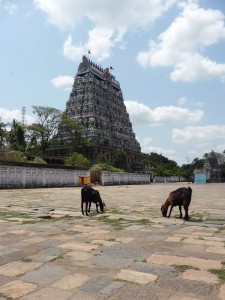

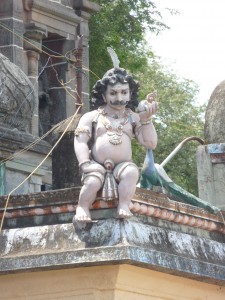
My original plan had been to ride along the coast to India’s southernmost tip, Kanyakumari, and go to Trivandrum and further up in Kerala to play with musicians there. However, with gigs in Bangalore and Madras continuing into the middle of the month, time was running out – and I didn’t find musicians in Kerala yet either. I need a producer! (And a cameraperson, pr hero, accountant, fundraiser, mechanic, and sound technician.) Then Ranvir Shah told me about the Sacred Music Festival, organised by his Prakriti Foundation in Thiruvaiyaru every spring, and invited me to come along and play there. Followed three days of concerts and being shown around the temples and countryside of the area, including a great lunch (oh I’ll miss South Indian food) at a restored traditional house, now open for tourists.
On the second night of the festival, I had to honour of playing with nadaswaram artist Mylai S Mohanraj and his group of nadaswaram and tavil players. Unprepared and without much discussion (music being the only language we both spoke), I added my grooves to their powerful temple songs. Newspaper The Hindu noticed.
The next morning, after a dawn visit to the Brihadeeswarar Temple in Thanjavur, I rode on – direction northwest, from now on. Redneck in stead of sun in the face.
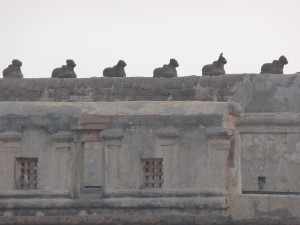
bye bye broadlands
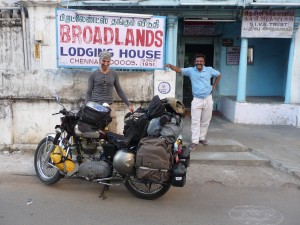 I was planning to leave at check-out time. 11 am. So, perhaps unsurprisingly, after postponing waking up for half an hour and taking my time packing, I left my luggage in Klaus’ room and tied the suitcase that lives in Madras onto the bike to take it back to the studio – tried to get a rickshaw but they were on strike till 6 pm. Grr. But actually nice, a last bit of riding in Chennai. Lunch at No Reel Corner, around the corner from Maarten’s studio that was half my home in the last five months, was good as always, and equally unsurprising was the espresso at Barista’s on Khader Nawaz Khan Road. I spotted a cybercafé and since I had no idea when fast internet would be available again, I spent a few hours uploading clips and tracks of the first Elephant Songs, that took place in Bangalore the last two weekends.
I was planning to leave at check-out time. 11 am. So, perhaps unsurprisingly, after postponing waking up for half an hour and taking my time packing, I left my luggage in Klaus’ room and tied the suitcase that lives in Madras onto the bike to take it back to the studio – tried to get a rickshaw but they were on strike till 6 pm. Grr. But actually nice, a last bit of riding in Chennai. Lunch at No Reel Corner, around the corner from Maarten’s studio that was half my home in the last five months, was good as always, and equally unsurprising was the espresso at Barista’s on Khader Nawaz Khan Road. I spotted a cybercafé and since I had no idea when fast internet would be available again, I spent a few hours uploading clips and tracks of the first Elephant Songs, that took place in Bangalore the last two weekends.
I had a vague idea I’d be doing the usual: take my time in the cool part of the day and go outside when it’s hottest, around and after lunchtime. Fortunately, after loading the bike and chatting to fellow Broadlands inhabitants, it was already five o’clock, the heat was disappearing and the shadows were longer. We said our goodbyes and I wobbled nicely down the beach road, past the San Thomé Cathedral (again not visited this time, despite really liking the place when I discovered Madras in 2000) and across the bridges. Took a left to Elliot’s Beach for a final Barista moment (mostly because I simply really like Elliot’s Beach). Puffed up with pride when someone started talking to me because of yesterday’s article in The Hindu but slunk away to order my coffee when his attention, photographs and all, was aimed exclusively at the bike – by whose numberplate he’d recognised me to begin with.
Rode into the fading daylight and of course got lost. With lots of friendly help I eventually turned onto the ECR – to find out the bike still doesn’t really want to do more than 60 kilometres an hour, 70 max. When I open the throttle, it speeds up as expected, until the increase suddenly stops. More gas doesn’t seem to make a difference. Or do I not dare to try hard enough? Better get the timing checked & tuned tomorrow. Is that stronger shaking, especially at low revs, because of the new, larger sprocket or does the time of the spark, and thus the explosion, also play a part in that?
At some point the engine just died, after having been feeling uncomfortable for a while. Turned out I was very low on petrol, but this didn’t feel like just running out of petrol. Or did it? Have to get reacquinted to this bike, its smells and temperature and movement.
Arrived in Mamallapuram and a friendly American at the bus stop told me about this hotel. Acceptable meal on a rooftop, with fantastic tomato soup – actual chunks of garlic and tomato in it. Kashmiri shops and tourist-friendly restaurants with matching prices down the whole street. Lots of dreadlocks, flowy cotton clothing, and bare tanned arms. An Israeli with a bushy beard and mourning eyes tried out the overtones on his plastic recorder in a shop door. Am I back in Thamel? Ah no, they have a beach here. With cows, of course. Having dinner in the sea breeze is a good feeling.
jamming with egor in the broadlands
While I was grumpily attempting to whack the replacement rear subframe into the right spot on my bike so that it would line up with all the appropriate holes in the frame, a short Russian with a razor-straight fringe till just above his eyes started talking to me. The combination of my mood and his complete lack of English kept the conversation fairly superficial, but I did gather he was part of a group or band, which also featured a clarinet and/or saxophone player.
When later that evening I found myself at a birthday party for no one’s birthday in particular, organised by five confident and comfortable girls who in no time fully colonised the top floor terrace of Hotel Broadlands, Egor the saxophonist turned up – with the saxophone he had bought in an antique shop somewhere in Madras.
elephant songs #1 – all star jazzband
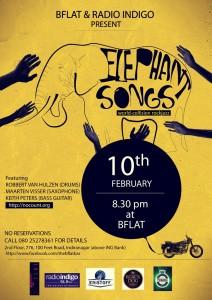
The first official episode of Elephant Songs played in Bangalore for two weekends in February. We kicked off at the famous B-Flat in Indiranagar.
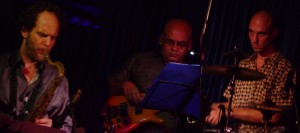
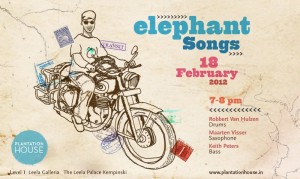
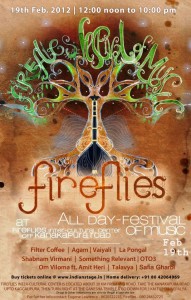
elephant songs #0 – surprise prologue
A few days ago I had an enjoyable hour of chatting and playing on Yugi Sethu’s talkshow, in the company of friend & multi-talented singer Yogeswaran Manickam, also known as Yoga. The show is scheduled to be broadcast next Saturday, 21 January, and will be available online too. We talked about music, about India, about motorcycles, and of course about how all those things and more combine in my upcoming trip. We also discussed the origins of the name Elephant Songs and what that phrase means to me.
When afterwards I switched my phone back on, I found an urgent message: if I’d be interested in a recording session the next day? Yes please thank you very much – and then of course the question what to do there forced itself on me. I had’t planned to start the Elephant Songs adventure till mid Feb, but I guess this trip will be all about grabbing opportunities when it presents themselves, and there’s already a few more exciting things coming up before riding to Bangalore to play at the Fireflies festival on 19 February as my first post-Chennai stop. Call it an extended prologue.
On the evening (night, on the Indian schedule) of Friday 13 January, Maarten and yours truly took drums and saxophones to the beautiful VGP Studios on Mount Road, where we met Yoga and organiser Jai Shankar Iyer and studio magician Greg Simmons with his team of eager Australian sound engineers. The spaces looked like bank safes, with big heavy doors. The recording room doubled as home to a number of unmatching parts of filmsets and whatever was hidden beneath its wonderful red carpet redefined the term “sprung floor”.
I’d called Yoga after the talkshow, and he agreed to join the evening. I knew a few of the things he does, but also realised there is a lot I don’t know about him and I had no idea how he would approach this session. I’ve been playing with Maarten since he invited me to join oto.3 on my last visit to India, about a year ago, working with him in that group and in other combinations, including a weekly duo gig at a mediterranean restaurant near the Harley showroom. I don’t think Maarten and Yoga ever played together, though they’ve know each other for a long time and have both often worked with Paul Jacob. The latter, in an article in The Hindu, said something that very well describes part of my motivation for Elephant Songs: “What we create together is far more powerful than what I or any single musician can achieve on his own. We live in dark, difficult times of ethnic violence and power struggles. Music can do much to educate us, bring people together, make us feel our common humanity.”
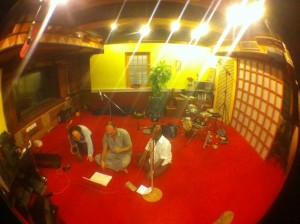
photo by shane choi
We took our places in three corners of the studio, facing each other, and after Greg finished setting up the mics, the first elephant songs were recorded.
Maarten brought a graphic score that he titled rolmops: with dots, lines, and squiggles he instructed us how to play our ways through a somewhat defined structure. We did three takes, getting more and more into it; Shane Choi filmed the largest part of the third take with his phone.
Yoga came with a beautiful lullaby that started with soft call and response phrases and then went into a gently rocking waltz. It was great to feel how we all played comfortably, in our own ways with our own instruments and backgrounds, at the same time listening to one another and creating music together.
I’d worked all day on an idea that ended up being called date shake, in honour of the fantastically refreshing frozen-milk-drink they serve in the juice parlours on Triplicane High Road.
When looking for information on Armenian music a few days ago, I’d learnt about their tetrachord system (or understood the information that way, I will never hold Wikipedia responsible for my haphazard interpretations). The system seemed to be about the intervals between the first four notes of a major scale, which are repeated from the fifth note up. Then treat that top half as the bottom half of a new scale, and you’ve modulated a fifth up. Playing with this I constructed a piece that keeps jumping around different major scales, in constant ambiguity as to whether the four notes start or end on the tonic.
In the studio, it turned out that elaborate structures and large collections of notes don’t necessarily lead to enjoyable listening. We ended up playing only the first two sections of my piece, the ones that consisted of an idea, an instruction, rather than a detailed score. Yoga’s melody had worked very well, because he just sang it and Maarten and I joined in. I, on the other hand, couldn’t sing my melody very well (having constructed it only hours ago). A good lesson: next time I’ll bring stuff I know well, that I can explain well, and that I have a clear idea for. Take it from there, make it our own once we get the basic thing. The project is called Elephant Songs after all, so let’s bring songs indeed. Also Maarten’s more workshop-like approach had worked well, that’s also a way to treat (part of) a session.
However, despite the insecurities originating with the feeling I wasn’t prepared well enough, I am very happy with this session. A good start to an intriguing project, with great musicians in a beautiful space. I’ll try and make this chapter complete by organising a show that will also launch the tour, updates will follow. Then the next stop: Bangalore! Two or three shows in the second weekend of Feb, including the B-Flat on Friday 10, and then Fireflies on 19. To be continued!
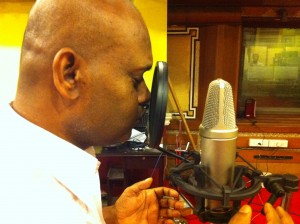
photo by shane choi
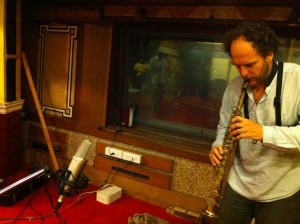
photo by shane choi
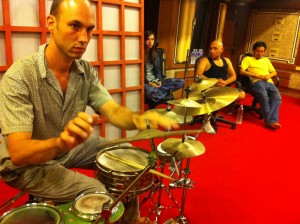
photo by shane choi
bullet, hanh?
I noticed them for the first time in 2004. Beautiful design, and a sound that makes a Harley hang its head and weep. I decided to one day ride a Royal Enfield Bullet to Europe, passing through all those countries I’d so far only seen through an aircraft window and on TV. Shortly after returning to the drizzly cold of the Dutch winter, I spotted one on the Amsterdam Nieuwmarkt – so it’s possible!
My friend Ned and I talked about augmenting our frequent musical visits to India with riding Bullets, but this dream never made it out of the swamp of possibilities, overtaken by more pressing, more interesting, more rewarding projects. Years later, I wanted to do something difficult and unrelated to the usual and got my licence. Intended to organise the motorcycle journey on my next trip to India, playing with chamber jazz trio oto.3 in the winter of 2010-11. I planned to buy a bike, prepare everything, come back a few months later and ride to Europe. However, from Chris Bright in the Adventure Motorcycle Handbook, Lalli Singh, and others, I understood that it’s impossible for a foreigner to get a carnet, needed for international overland travel, for an Indian bike. Solution: buy a bike (at a much higher price) in Nepal, where a foreigner can register a bike in their name, and to get a carnet. And if the bike is from before 1998, it even seems possible to import it into my home country, the Netherlands.
After returning to Amsterdam, I discovered a whole new world of motorcycle stories in films, books, blogs. Essential inspiration were Gordon May’s Overland to India and Benno Graas’ Het Aarden Beest. I enjoyed the classics – Jupiter’s Travels, Long Way Round, Mondo Enduro. Dirt Track Productions has a number of great films on riding Enfields in bizarre places, including Gaurav Jani’s amazing Riding Solo to the Top of the World, and One Life to Ride is another charming Indian biker story. A bit of Sons of Anarchy to learn how to make offers no one can refuse, and I’m ready to go.
October 2011, Kathmandu. Been looking for a bike since I got here. Quite a vibrant motorcycle scene, various clubs organising tours sometimes going as far as Tibet. At the workshop of the Himalayan Enfielders I met Dutch expat Willem, full of enthousiasm and good advice (sold me a pair of panniers too). Through Mariano from the Kathmandu Jazz Conservatory, where I taught some workshops, I met the very helpful Rabi Thapa, Enfield enthousiast and bike trip organiser for Sacred Summits. Great to hang out in the Handle Bar under his house with captain Mahesh and their biker friends – all riding Bullets, all with their own modifications ranging from skull shaped tail lights to hand-shifted gears. Rabi put me in touch with some people who might be interested in selling their bikes. A tempting option was a 1979 standard Bullet – engine like a clockwork and the bike looked gorgeous, a glowing kind of dark brownish rusty maroon. I may have been a little prejudiced because owner Manish also introduced me to the Himalayan Java Café where they serve easily the best espresso in Asia. I looked at a few more bikes, took some testrides. I liked their sturdiness, the power produced with deep one-cylinder sound, the comfortably upright posture. The bike is quite big and heavy in this traffic, could either be considered an advantage because people move out of the way (I’d like to think), or a disadvantage as you don’t fit through narrower gaps between traffic, and you’re simply less manoeuvrable.
[slideshow post_id=”1093″ exclude=”1337″]
Looking at all these bikes, I should have probably been a little more critical. I could have for instance have had a closer look at some tips and other tips on buying a used motorcycle. Also, I could have taken the bikes to independent mechanics, without interest in the sale – though I also think it was hard to see all the relationships.
I kept coming back to the ’79 maroon one. So, over another espresso, Manish and I agreed on the sale and the next day took the bike to the workshop. In the evening, his chopper-lookalike had metamorphosed into the Bullet I was looking for. New seat (though a single, sprung seat still floats around in my head), mirrors, wider handlebars, new mudguards. The Vintage Motorcycle Club had a charming atmosphere (and got me the best momos, and had former king Mahendra’s former BSA in a corner waiting to be fixed up), and organised a nice and easy ride up to Nagarkot a few days later, but I wouldn’t recommend anyone to take a bike there. Their mechanic was a little too quick rounding your bolts, and had as his favourite tool the hammer. (The little boy who helped out is someone to look out for though – had a care and patience that might make him and excellent mechanic in a few years.) Apart from the sloppy job, they sold me spare parts at a multiple of their original prices, including an inner tube of the wrong size, and adapted their diagnoses of gearbox trouble I’d noticed since the beginning after consultation with their friends. Frustrating because of its dishonesty, but “Too late to bargain now. I owned it”, as Hoohoohoblin put it.
Getting the bike registered in my name, obtaining the “blue book”, the Nepali vehicle registration document, was handled by a middleman who knew which document bring to which desk at what time. Endless cups of tea, signatures, finger prints, and desks with a variety of authoritarian men later, having managed to make ourselves heard amongst everyone who wanted to be helped at the same time, the bike was legally & officially mine. My portrait in a little blue book. I’ve got it! I concluded the whole process with a few days of riding around the country with Sanderien, who had come from Gujarat for a week. Then my carnet was delivered from England at Hearts & Tears and I was ready to go.
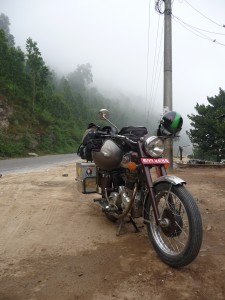
To get a carnet from the RAC I sent them the application form, photographs of all the (filled-out) pages of the blue book and their translations, and the bank statement of the payment. They let me apply while still looking for the bike – I filled out the application as far as possible and sent them the frame & engine number and the copies as soon as I’d bought it. Paul Gowen, Mr. Carnet, was busy but very helpful. (Contacting him with “Carnet question via Horizons Unlimited” in the subject line helped.) The deposit on the bike for the overland route to Europe is 500 % of its value – seems to be generally estimated at £ 1000 for a classic Bullet. (It’s possible to pay the full amount, or get insurance for it.) You can view or download a rough idea of a translation of the blue book as a pdf or txt document. Use at your own risk, I don’t claim this is accurate, complete, correct etc, it is only intended to give you an idea of what the translation could be like. It contains contributions from several people, varying from a distracted hotel owner to a guy in the office next door whom I thought worked there – he didn’t, just came in to pick up some flight tickets he’d booked before – and the previous owner of the bike. This translation was awarded the carnet.
oto.3 these days (and: movie edit!)
After editing the footage of riding through Nepal, included in mountains! please? iMovie was no longer the intimidating dark cloud that had stopped me from putting up clips of the oto.3 concerts in Amsterdam in the early summer. So here it is, enjoy!
And all those who missed those shows, don’t worry because new opportunities are around the corner! To begin with, we played at the wonderful Plantation House in Bangalore last month – dressed in fine shirts provided by designer & maker Shalini. Yesterday, Tuesday 20 December, we performed at the launch of basement21, the newest & hottest artists’ collective in Madras, South India, concluding a two-day programme there. On Monday 19, German / Belgian choreographer Arco Renz showed his work and discussed how his constant travelling all over Europe and Asia affects his work – and how it doesn’t, people being people all over the globe. Tuesday night was opened with short dance films (different from documentations of dance shows) from the Yellow Line Project, presented & discussed by Preethi Athreya, who made one of the films.
For more info on oto.3, including audio recordings and more video, check out the official page.
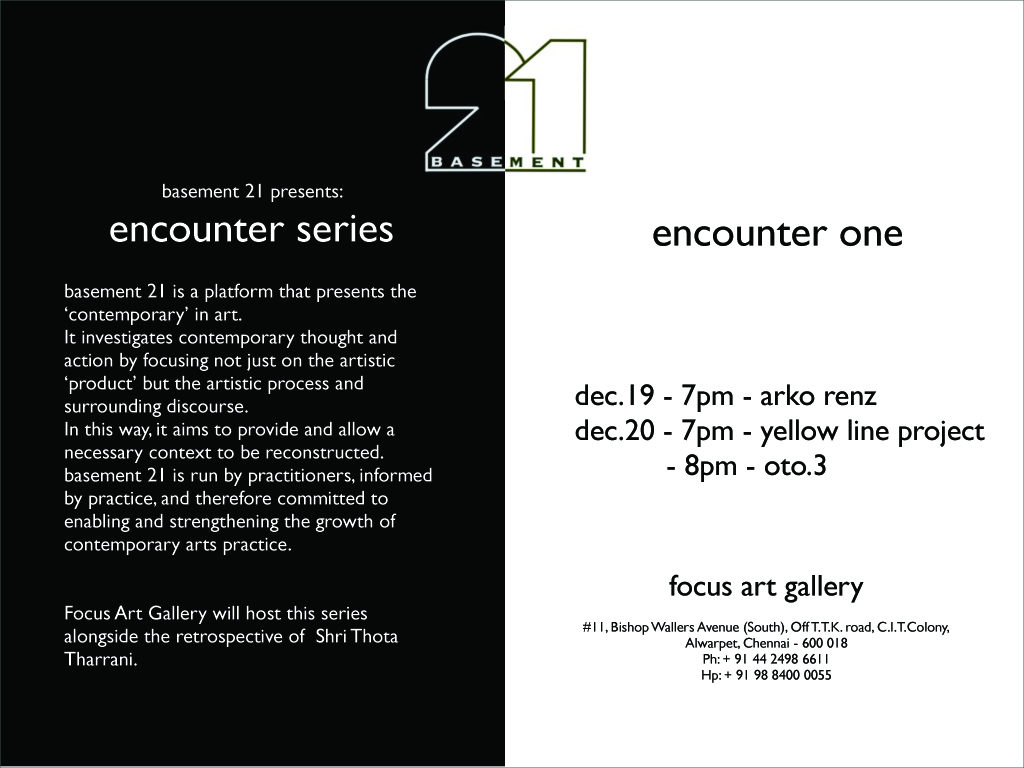
temporary homelands
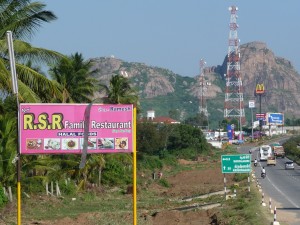 The hill crossing on the day I left Bangalore had to wait till after lunch – but then, so did most everything on that day. After spending many hours waiting for a meeting that never happened and accepting further delays caused by multiple half-decent but oh so welcome espressos (espressi?) in the very place where I first was introduced to non-decoction black coffee in India many years ago, I set out to find the highway. Now I now I don’t have a very strong sense of direction, but if this is supposed to be the fastest and smoothest way to Madras, don’t you think they could signpost it a bit better?
The hill crossing on the day I left Bangalore had to wait till after lunch – but then, so did most everything on that day. After spending many hours waiting for a meeting that never happened and accepting further delays caused by multiple half-decent but oh so welcome espressos (espressi?) in the very place where I first was introduced to non-decoction black coffee in India many years ago, I set out to find the highway. Now I now I don’t have a very strong sense of direction, but if this is supposed to be the fastest and smoothest way to Madras, don’t you think they could signpost it a bit better?
When I eventually found the highway, my stomach told me it was lunch time, so I pulled into the parking lot of what turned out to be a non-veg restaurant mainly catering to people imbibing vast quantities of cheap booze. You’ve got to give it to the non-vegetarians though, the food was excellent, tasty and spicy.
After lunch and the hills that followed, I rode into fields of green coconut plantations in neat rows and other vegetation with rocky hills rising out the the rolling landscape here and there. Sometimes the hills turned into mountains – higher, bigger, less green and more rocky.
I slowly realised I’d never make it to Chennai, and then also gave up on Vellore. Just before dark I found a stuffy room in a friendly hotel in the busy little town of Ambur. The bike found a place to stay for the night in the guarded parking lot next door and I went for a walk while the powercut left the room in the dark. I found a dosa place that looked good, but felt like walking a little more. Food on my mind, I was trying to rembember where I had my first dosa, not more than a few days ago. I’d missed those sourdough lentil-rice pancakes, very happy to be back in their native lands. Thinking about local dishes, I realised that I hadn’t had pav bhaji anywhere in Maharashtra – the red stew eaten with white buns drenched in clarified butter. Not that I really minded, my relationship with the stuff has always been somewhat ambiguous, but when the sweets shop I entered for juice or tea proudly announced to have the Marathi junkfood on the menu, I didn’t resist. I asked the cook to put cheese on the sandwich I also ordered. He looked hurt and confused, was silent for a second, and said no, it has butter and chutney. The food was mediocre and when I washed my hands afterwards, a gigantic cockroach didn’t even try to hide in the woodwork around the mirror. I did not stay for tea.
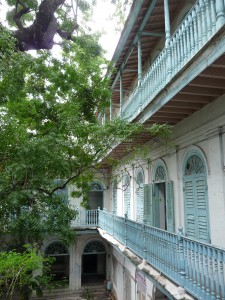
After the confusion of the Poonamallee High Road (mainly caused by my wondering if I was on it or not), I quickly found Triplicane and parked my bike in the courtyard of my home in Madras, hotel Broadlands. The testride from Kathmandu to South India, some 3,500 kilometres, has been a great pleasure and I’m looking forward to got on to the road again in four or five months. But first, let’s find out what a musician’s life in Chennai is like.
strong hands and candle light
Had had a great day and a half at the Shisha Café in Pune, playing a good show with saxophonist Maarten Visser and bass player Mishko M’ba and hanging and, not to be forgotten, eating lots of fantastic food washed down with mint cocktails and dhoog, a salty Iranian lassi with mint (anyone have a recipe for that?). During a few great days in Pune including , Mishko asked me if I really was going to give up now, as I was planning to take a train from Pune to Chennai to save some time. Turned out of course I wasn’t – no train was found and I didn’t try too hard as completing the whole trip on my own two wheels was a very attractive idea anyway.
So on Sunday morning, 20 November, after another day’s break with Pierluca and family at their house on the beautifully quiet compound of the international school where he works, I rode out onto the NH4, the highway between Pune and Bangalore.
Beautiful hills around Pune. Not for the first time I was reminded of Arizona in the USA. Red sandy rocks, dry, the hills abruptly sticking out of the plains. Around 60 kilometres before Satara, the speedometer gave up again, and in combination with the horn that had now completetly stopped working, this was enough reason to pull over at a garage. There was nothing they could do about the speedo, but my broken horn was replaced with a nice loud one. The broken horn had imitated a bad pop song: jumped up half a tone at a crucial moment. And, like we know from the bad pop songs, that means the end is near. Can’t say I wasn’t warned.
Feeling good, I rode on. Confident. Around Kolhapur, the landscape changed – the hills no longer dominated or rather formed the landscape, but interrupted it, and the plains out of which they jumped got more and more green. Sugarcane is a favourite, lots of fields with the high waving reed. Alternated with empty patches, explained by the numerous ox carts and tractor pulled trailers full of the stuff. Got stuck behind a lorry for a while because the guy in the passenger seat tried to pull a piece of sugarcane off a trailer they were overtaking. Laughing and pulling, he gave it a fanatical try, until his driver got fed up.
Riding into Karnataka, things kept getting greener. I got the idea it’s essentially still very dry, but I crossed a number of rivers (so wide…) and it seemed they’ve got a good irrigation scheme going. The road was shiny and black, and the traffic not too dense, so in general it was pleasant riding. Still, there’s the occasional taste-of-shock moment, for instance when two boys on a motorcycle crossed the road. I figured they saw me, and would either speed up or slow down. He didn’t do anything, so I had to hit the brakes to avoid slamming into them. A litte while later, a similar incident had a less fortunate ending, though I was not involved. For some mysterious reason a dog all of a sudden took off crossing the road at high speed and miraculously reached the divider in the middle of the road undamaged, only to run straight under the wheels of an oncoming lorry on the other side. I couldn’t watch too focusedly as I had to stay aware of the traffic around me, but the last thing I saw was the dog on his back, motionless. Hope something essential broke quickly, making the whole affair fast and painless – though that may be too optimistic. In general though, there’s a lot less roadkill than earlier, probably because the traffic is so much denser.
I’d ambitiously set my goal for Hubli, with Belgaum as an alternative. Naturally I ended up in Belgaum, in the charming bus station and market area. Found a tiny room in the Relax Hotel (picked for the name, of course) and left the bike at the guarded bus station parking.
[slideshow post_id=”1450″ exclude=”1745,1746,1757,1758,1759,1760″]
Had a stroll around, and popped in to one of the little barber’s shops for a shave. I love that feeling of just sitting back and surrendering. Half done, the electricity went off. Strong hands massaging oil into my scalp by candle light. The gobi manchurian I had afterwards was bright red and fried to the point of burning. Exactly as it should be. At the market, some vendor I asked for cigarette paper wanted to sell me lots of jam and soy sauce and tomato sauce. Very cheap price sir, I needed it for myself, for my family, for all my friends. Didn’t matter I told him I’m travelling with as little luggage as possible – and if he’d see the amount of stuff that fills my room at the moment, he’d rightfully argue I’m not doing a very good job at that anyway.

It seems I’ve gotten into the habit of starting the day with crossing some hill range – first thing on the programme the next day again. Beautiful, as usual. After the hills though, things became a little too northern French – just fields and fields and fields, flat and boring. Sometimes industry. Sugarcane, later a crop I didn’t recognise – very dead looking with big white flowers. Till I realised they weren’t flowers, but fluffy white balls – cotton! My assumption supported by the room that I walked in to looking for the bathroom (pinky) in which, Joseph-Beuys-like, a whole wall was covered in the white balls.
The hills were reminiscent of Hampi – large boulders, looking like glacier deposits and making me wonder again if there’s any ice age history here. Something to find out. The fog gets a bit much at times – if not caused by industry or exhaust fumes, it’s because people are burning stuff on the side of the road. Any rubbish they can find, no matter what substance. They talk about living in big cities being an attack on the lungs, but try riding down an Indian highway for a few days…
After the turn-off to Panaji, Goa, the road became two lanes – apparently I lost the highway and stayed on the parallel road for a while. That was fine too, I seem not too worried about the traffic anymore. Was the road to Goa tempting? Not really, I’m looking forward to a few days of relaxation but not as a break. I didn’t come here for a holiday, I’d rather take it easy in Chennai for a bit while preparing things and start meeting people, as it will all take some time to pick up anyway.
Apart from two very friendly Bangaloreans who whizzed by a Bullets, I saw further proof of the strength of these machines when I encountered a small pick-up truck towed by a 500 cc Enfield bike.
I met more Bullets, all on their way back from a big Enfield rally in Goa. They rode at speeds I wouldn’t dream of – I’m still too uncomfortable with the traffic or too worried about the bike, though theirs might have been newer and / or stonger models too.
Speaking of traffic, I’m starting to understand the crossers: they often do see me, but are simply calculate their speed according to how fast they see me coming. Still, I’ll keep slowing down, just in case they didn’t see me – not too rare either.
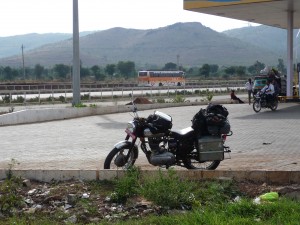
Eighty kilometres before Bangalore, darkness fell. What to do? Lost precious minutes of daylight trying to make sense of the contradictory instructions to find a lodge in or around Tumkur – eventually I seemed to have to go back on the highway, in the direction I came from. No thanks, so I carried on direction Bangalore, only to see, within minutes, a lodge on the right hand side – next to the fly-over I was on. Impossible to get there. Carried on in the darkness, having the usual blinding trouble with highbeams of oncoming traffic. They make it impossible to see what’s coming, to recognise if it’s a truck, a rickshaw, a small car – consequently, I can’t guess its speed. When yet another couple of small cars cut in trying to overtake each other while overtaking a truck that was in the right lane I relaxed: just let them do what they do, crazy or not, and stay out of their way. Then realised that only minutes before I’d forced myself in between a bus and a lorry that were overtaking a slower lorry – what’s the real difference?
Then, oh joy and relief, after the toll booth: street lights! All the way to Bangalore. Rode onto a fly-over and only when I entered it I saw the sign that two-wheelers can’t use it. A lucky mistake: in my elevated state, I flew over the ant hill below. I wasn’t too worried as there were a few more bikes, including one being pushed – against the direction of traffic. Traffic was jammed till we passed a small truck with a smashed cabin turned in our direction – another ghost rider or a high impact collision?
It felt just like Bombay, coming off the fly-over into motionless traffic, but it soon opened up and I was in Malleshwaram in a few kilometres. Didn’t find a place to stay there, so I rode on to my trusted Shiva Ganga in the weaver’s and tailor’s area Balepet, only losing my way once. Unloaded the bike and went to Sheethal’s to shake the boss’s hand and have a great masala dosa and kesari bath, washed down with a wonderfully strong cup of tea, South Indian style.
congratulations in india
After a few very pleasant days in Anand, I needed a few hours to get comfortable in interlocal traffic again. Sanderien and I had been riding around, city style, mainly from coffee to lunch and back. The highway was difficult: three lanes, with the slow and large traffic in the middle. I’m supposed to be in the far left lane with the other two-wheelers and tractors and rickshaw. But, my speed being much higher than theirs, it’s safer and easier (same thing?) to overtake in the fast lane – but that’s where the fast cars are as well, zooming around the slow traffic. They own the road, brake, change lane, stop without warning. The traffic was dense, and I was not enjoying myself.
A bus that I was overtaking started overtaking a truck, filling the lane I was on. We were nearing a bridge with a high sidewall, and by the time we got there I had so little space my foot brushed the concrete. The whole time I was calm and convinced I could avoid real danger by acting the right way, and I did. Shockingly uncomfortable, though. Tried to get past the bus for a few kilometres but it was too unpredictable, swerving across the road rushing from gap to gap between other traffic. I pulled over for a soothing cup of tea.
A little while after getting back on the road, a grey SUV almost drove into me doing a U-turn, its speed no reason for concern but just so careless… I was not happy on the road, so I stopped early. Found a hotel with vacancy a little after Bharuch, around five o’clock. They kindly told me to wait till namaaz was over and they’d show me the room, which turned out to be perfectly acceptable. Nice restaurant, early night and I’m planning to have an early start tomorrow – if all goes well, I’ll be in Nariman Point cinema tomorrow night, or else I’ll find a place to sleep just after getting onto the road to Pune, avoiding Bombay’s nightmare traffic.
***
I left early in the morning, after confirming my suspicion that the orthodox-Muslim looking, white-clad and bearded proprietor of the hotel and his colleagues were Momin. My question got me a big smile and an extra handshake. These Momin are all from the same village: one village runs the entire catering industry on the highway from Gujarat to Bharuch, I’d been told. And apparently further south, too: till Surat, and all the way down to Bombay they still ran a lot of roadside places, though they were no longer the only ones. I had a lot of Momin tea that day.
The road was still too full but it felt better, or maybe I felt better. Enjoyed my first cup of Bombay tea after spending some time riding through the suburbs, and was told it’d be another two hours to Colaba in the deep south of the city, because the traffic wasn’t too heavy this time of day. I expected I’d recognise more the further south I got, but I just kept getting lost until I suddenly found myself at Flora Fountain. Spent the evening walking around Colaba and reading the book about Gujarati prime minister Modi I just bought.
***
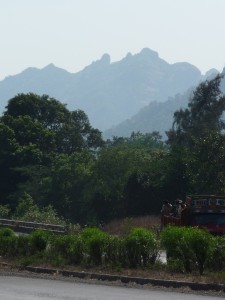
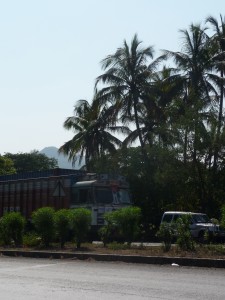

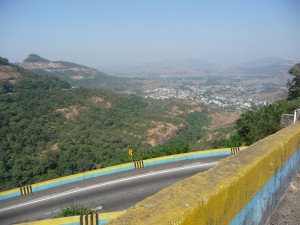
As soon as I left the suburbs, the road to Pune started with a pass over brown-and-green hills. This was clearly not the road the bus takes – that must be the express way, off limits for two-wheelers. I think I did join it at some point, maybe there’s only one road for part of the way. Got off that shiny and busy road when it seemed right, and continued down the smaller road.
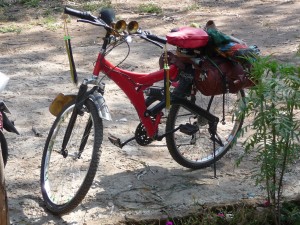
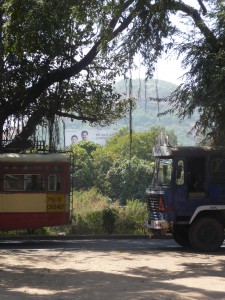
I arrived in Pune well on time, found Koregaon Park and the Shisha Café easily enough (turn left, continue till you get there), and enjoyed a nice reunion with musician friends for a few days.
udaipur rooftops
Had lunch on a blitzvisit to Udaipur after riding the last 250 kilometres on the fantastic NH76 cruising at about 80 kilometres an hour. Something doesn’t work out in this equation but I don’t know what it is. The fact that I started out riding more slowly, like every day? The engine seems to like 60 in the early morning, then slowly moves up to 80. Sometimes it would like to go up to 90, but I don’t usually let it – let’s find out a little more about this bike first, its likes and dislikes and its strong and weak points. Or was it my late departure, due to more poha in Bijolia before leaving, as opposed to my usual habit of covering a hundred kilometres before breakfast?
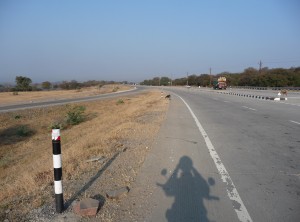
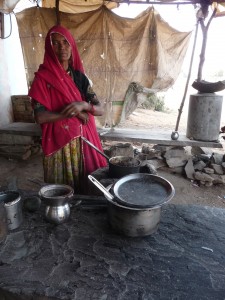

Back on the road I realised I was no longer so easily shocked by the traffic, even though it was getting more intense as I came into a more populated area. Rolled in to Udaipur and easily found the Lake Palace Road – German bakeries, English speakers, white people in shorts, and screenings of the James Bond film Octopussy advertised in all the rooftop restaurants.

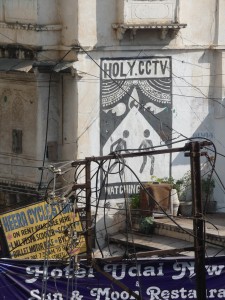
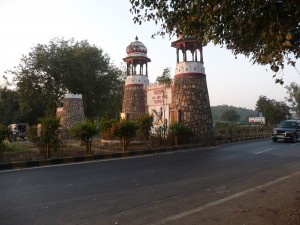
In Modasa, I was turned away for not being Indian by a succession of hotels gradually moving into the center. My fuse kept blowing up and I was getting a little frustrated with the progress of this evening. Being eventually out of fuses I tied the wires together directly, and stopped at my last resort with smoke coming out of the headlight and the smell of burnt plastic. Spectacular but a bit worrying. Finally found a hot, expensive, and unclean room and nothing to eat anywhere, not even at the bus station across the road. I bought water and crisps from shopkeeper Usman, and optimistically asked him if he had some electrical wire. To my surprise he started rummaging around on his floor and pulled an unconnected dusty meter of cable from behind a cupboard. If this would be of any use? Most definitely, Usman, thank you very much. I walked back to my room, looked at my bike that was parked on the pavement of the main road next to the bus station. Must remember to make safe parking a priority? Sometimes it just doesn’t work…
Next morning as soon as it got light I checked the bike – nothing seemed wrong in the headlight. I fixed the fuse with Usman’s electrical wire. It worked fine, so slightly puzzled I rode the bike to a good parking spot, parked, and the fuse blew again. There was no problem with the brake light switch, so what could it be? Looking for electricity clues, I noticed the chain was very slack. Cursed myself again for not having tools. While waiting for the mechanic someone promised me, I looked for the last electrical thing that had been touched on the bike. In Kota, the mechanic had been connecting some wires in the front of the bike, when I couldn’t leave because all electricity had gone. And indeed, the connection was unisolated and caused a short circuit when turning the handlebars – to park the bike, for instance. Still waiting, I had breakfast and a shave and then got fed up, asked the wiry hotel man if he knew someone. He did, and took me there, introducing me as German. “Indian mischief”, he explained, folding up giggling and slapping my back. The chain got fixed, and the uncovered connection taped. Then the mechanic tore a strip off his rag and tied the cables togetherl dismissed my fuse solution, and sent me on my way. I loaded and left and put in my fuse solution at the edge of town and put my biking gear on.
Rode into Anand hours later, found the Vidyanagar Coffee Day easily and was completely happy with my double espresso and brownie while waiting for Sanderien.
poha!
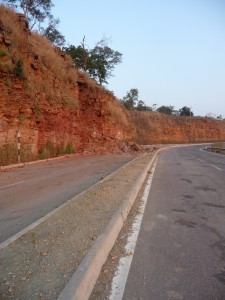
A little later, slowed down for a herd of cows taking their morning walk – I think around 200 cattle, cows and water buffalo, covering all four lanes of the road and its shoulders. Once again I regretted not having a fast way to take photographs.
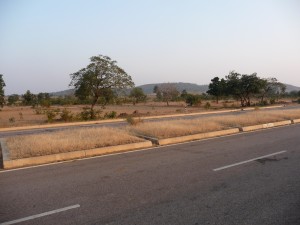
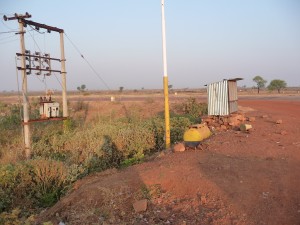
What to do when your tire blows at 90 km an hour? Hold on, tell yourself to take it easy, let it swing but let it slow down too. It’ll be okay. Then I remembered hearing about using your clutch being a great way out of certain emergency situations.
The one at hand was not one of those situations, it turned out – without the back wheel being gently slowed down by the engine, I lost control and was launched headfirst onto the road.
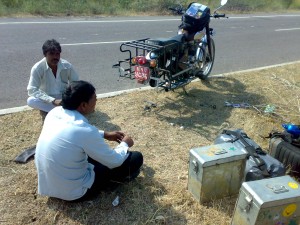

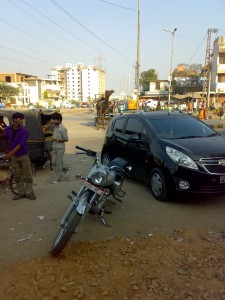
I left the bike at the Royal Enfield dealership in Kota and one of the boys rode me to the nearby mall. I limped around in the airconditioning for a while, had an acceptable dosa in the food court and sat down for a double espresso at the always slightly disappointing Café Coffee Day. Now that I sat down, with nothing to do, I realised how tired I was.
After the bike was done, I found my way out of town, getting to the highway after only a few wrong turns. But what happened to my lovely NH 76? A slab of tarmac in the sand, unclear edges and only just wide enough for two directions of traffic. Traffic which consisted of slow and loud black diesel smoke spitting trucks. The image was probably nice – late afternoon light, the picturesque trucks, through a dry landscape of sand dunes and sturdy bushes.
Helped by two friendly guys on a bike that I could almost keep up with, I merged onto the main highway and rode on, relieved to be on my way again. Exotically echoing the cattle this morning (a long time ago now), a herd of camels cross the road, silhouettes against the deep twilight in the west. Time to find a place to stay. Which turned out not to be too readily available, I had to continue another 45 kilometres to get to Bijolia, I was told. Bijolia was nice enough though, a big room on a large courtyard full of cars and bikes and building materials. A group of Sikh men cooking a delicious-smelling potato concoction. The square outside the hotel had bicycles and pigs and poha! One of my favourite breakfasts, that I used to have daily when staying in Pune for a few months, a few years back. It’s yellow rice, pounded in some way. Onion chili garlic and served with coriander and these deep fried vermicelli they use for snacks here. Two plates of that, a few cups of good tea, and ready to retire.
till the cows come home
Oohhh I like it here. Warm and welcoming and friendly. Mister Gautam showed me my room in the Government Resthouse – a small palace, slightly crumbling in a grandiose way. A bath room full of big black ants and their deceased kin, a western toilet, and hot water! High ceilings, a large supporting arch in the middle of the room, double bed, sofas, table, curtains, a little mosquito repellent thing that plugs into the electricity outlet (is there a name for these things?). Makes me feel like I’m in Upamanyu Chatterjee’s English, August. Also the lovely small-town feel. So at ease. Mister Gautum is a Civil Servant in the roadworks department, managing the resthouse is one of his duties. He treated me to a cup of tea when I walked by, on my way to find something to eat. We had a little chat, then I moved on to the hotel, as they call restaurants in India. (If you want to sleep, ask for a lodge or guesthouse.) Great food – but what’s with the chapati? Always waiting for you to finish your chapati, only then you get your rice. I gave up tonight – they kept bringing the little bread pancakes, so I just didn’t have the rice. I guess it’ll all be ok once I make it down south.
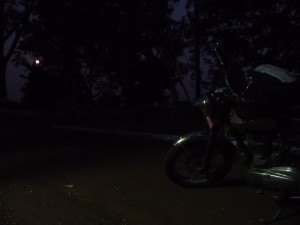
When I’d left in the morning large chunks of meat were scattered over the road, initially one or two every hundred metres or so. Too many to simply have fallen off a truck, or not? Went on for kilometres and kilometres, with towards the end a large amount just before the toll booths. After that it was a little less, until it stopped. Cars swerved to avoid it, but except that no one paid any attention to it, apart from the crows and the dogs.
Photographs that were not taken today include the lonely, bright purple flowers in the divider of the road, the herd of camels in the early morning, the very beautiful and incredibly bored-looking girl on the back of a motorcycle, the two trios on motorcycles, whom I later met at breakfast (paan stained smiles from six happy people), the piaggio full of bones – probably water buffalo though I imagined them to look rather like small elephants.
If a crashed vehicle faces the oncoming traffic in the places where I learnt driving, it’s usually a sign that something went very very wrong. Now, judging by the way the front end often looks, or by the fact that one example consisted of a burnt out truck and a twisted frame of a tractor, the assumption that some of these accidents are serious is a safe one. But the reason one of the cars is facing the other one, is usually because it already was – it was heading in the opposite direction. Why take a detour if the only price you pay for the shortcut is going against the flow for a while?
There’s more that I’m not used to on these highways – speed breakers, for instance. Usually unmarked – except in the puzzling case where a sign appeared after two rather mean, high bumps, causing me to drive extra carefully for another kilometre or so.
I rode for a long while, teabreaks providing welcome relief from the unforgiving saddle. At some point during the ride, on one of the many intersections that a village always is, a small green truck some distance away turned and blocked my path. I reacted appropriately, and only after that I realised I’d done that fully automatically, hardly registering doing it. I noticed having slowed down, then realised the truck was there and that its appearance was the reason for my actions. Good to know I’m that reliable, but clearly time for a break. More sweet strong milky tea, please.
Just before Kanpur, I crossed the river Ganga, its banks full of people. Ready for today’s festival? The city on the cliffs that rise up steeply out of the river, housing (busy, people ready for the festival?), Kanpur on the other side. The banks rose up steeply, vertically, housing lots of swallows. I rode through some suburbs and lots more country, later on crossing the Yamuna river. I came – around Orai, if I read my map correctly, by a beautiful big palace in the style I always think of as Moorish. Similar to some of the things in Hampi. Would be nice to know more about India’s history and be able to understand why that building looks like it does.
Around Jhansi, the land became hillier. Then an irrigated area started, much greener. Back to Savannah, reminds me of pictures I’ve seen of Africa. The ones with the giraffes. For a while, there were a lot more cows on the road. Then, after riding around a lake that didn’t show on the map and featured boats as well as submerged buildings and trees (a seasonal lake? overflowed river?), I rode up into the hills. On the other side, a maroon bullet and its handsome rider came down, enthousiastically honking. For a few kilometres, cutting through the hills, there were no cows. Only large, fierce-looking dogs and a few monkeys with halos of white hair. Up on the plateau, the cows were back. The land moved between savannah and cultivated plots separated with small walls.
When I ran out of petrol, a man stopped on the other side of the road. It turned out the few buildings I’d seen about a kilometer back, were a village with a man in a garage who had a large drum of petrol. He sold me one in a plasic bottle with no top, and my saviour took me back to my bike, which we’d left in the care of someone who was with him. He wouldn’t accept anything for his services, and after we said goodbye I was on my way again. Riding into the beautiful national park, just road and dark green trees and hills. Still savannah. Here and there ruins of buildings – what happened there? Evicted when the area was turned into a nature reserve, or simply abandoned? No sign of population anywhere. The air felt pleasantly cool at the end of the afternoon and with the riding wind, while the sky was becoming a slightly deeper shade of pale blue.
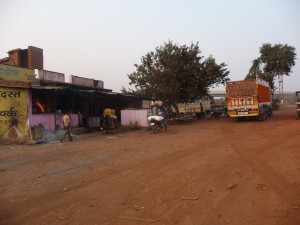
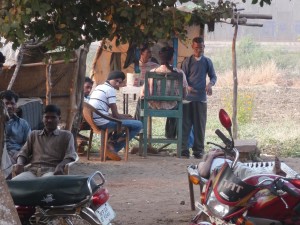
After filling up at the petrol station a few kilometres onwards, the signs still told me I was on or on my way to the NH 76, the road to Kota. Very quiet, lots of cows going home. And why not? There’s more traffic of cows and goats and farmers than motorised vehicles here, so it’s only logical they use the easiest road, in fact simply the there is. Two kids, against the traffic direction, very relaxed, chatting on their bicycles. No problem, just swerve around them. All so calm… water buffalo cows goats, dogs – strays or employed?
Kishanganj had seemed nice conclusion of today’s ride – on the banks of the river Parvati, the third holy river of the day (they’re all holy, aren’t they). However, when the sun touched the hills on my left, I stopped to exchange my sunglasses for clear ones. When I looked up again, the sun had disappeared. Kishanganj another 75 kilometres away, and though the road was in excellent condition, I didn’t want to risk not seeing cows, boulders, things fallen from trucks, or unlit slow moving vehicles. Skipped the turn-off to Dewri as I’d decided for Shahbad because it sounded nice. And indeed, I couldn’t have wished for a better place to finish the day. Some villagers argued about which lodge to send me to, but a tall smiling man dismissed all the other ideas and decidedly showed me the way to the Government Resthouse. Of course I don’t know what the other one(s) were like, but I’m happy here. I’ll save Parvati for breakfast.
test ride day one – my way is the highway
Got up in my Nautanwah hotel just before sunrise, brushed my teeth, paid my rs 50, and pushed the bike out of the courtyard. It was still there! Even the petrol! Was feeling a little apprehensive about leaving it there last night after some semi-aggressive guy kept going on about arranging things for me at the border (which I’d already passed), owning the whole place, wanting an extra charge for the bike parking, and me not being in my own country. No idea what the whole point was, but it was all vaguely threatening. After I’d checked in, some friendly boy had turned up from nowhere and took me to a cheap & best little eating place. (Ahh … only in India does the dal taste like this – is it the cumin? the kind of lentils?) He simply took me there, declined all offers of food for himself, just hung around chatting to some friends here and there and making sure I ate well. I took him for a cup of tea afterwards and that’s where this other guy started talking to me and then walked all the way back to the hotel with us. There my escort disappeared, and I was left with this guy. After pretending not to understand him and remaining friendly for some time, I got fed up and told him the receptionist had already given me permission to park it there. He got quiet, looked somewhat confused, and disappeared slowly. The staff didn’t seem to think anything of it. I didn’t quite get the whole thing. Kept checking the bike every hour for a while, the staff continuing to reassure me it was ok. Finally I decided to trust the situation and went to bed.
Looking at the map before departing, I noticed that Gorakhpur, the originally planned destination for yesterday, was actually to the east, while I’m supposed to be going west. Fortunately, there was a direct road to Basti, west of Gorakhpur, which would cut some kilometres. Most people tried to send me via Gorakhpur anyway, but I found a happy bus driver who told me how to get to Banti, on the way to Basti. A nice small road, and sometimes the cold, fresh-in-the-nose fog even lifted enough to see what was on the side of it. Though soon I had no time to pay attention to that, riding the clearest evidence of McGregor’s law so far – bad roads are worse than no roads. What do these people do to their road surfaces? Unbelievable, kilometres of broken tarmac, I thought potholes by definition are holes in something smooth but here they proved their full capacity of independent existence. Maybe no road after all.

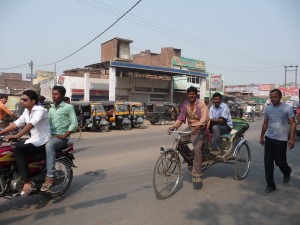
Another thing I had to get used to was the oncoming traffic – in our lanes, on the left side of the divider (don’t forget this is India, left side of the road traffic). Cycle rickshaws, motorbikes, fast luxury cars, and enormous All India Permit Goods Carriers. With their headlights on, so no one would miss the fact they were coming. That all this doesn’t alway end well was silently testified by the overturned and sometimes burnt out car wrecks on the side of the road.
Of course you’ve all read and heard lots of these horror stories – and of course they’re all true. But also don’t forget these are incidents, it’s at the same time generally ok traffic that you’re riding in. You need to stay alert but it’s doable. I sagely tell you, experienced as I am after a full day on the road.
Passed Ayodhya – where Rama was born – without noticing, then missed the signs to Kanpur and got lost in Lucknow.
Asked another motorcyclist: “You know the way to Kanpur?”
“Direct or bypass?”
“Easiest one.”
“Come.”
And he showed me out of town, back on to something leading to the highway. Got lost a few more times but not badly, on grand boulevards with matching buildings. Wanted to get out of town before stopping for the night, and just outside Lucknow, the sky showing the first signs of twilight, I pulled into the big and empty plaza of a roadside hotel. Very expensive, and looking fancy with dark blue reflective glass everywhere, construction not yet finished but the building already falling apart. The hygienic standards were appalling, but the hot shower was great, I scrubbed all the dust and dirt off me and put on clean clothes to go to dinner.
siddhartha’s way
Taking off from Pokhara, I easily found the Siddhartha Highway. This road was constructed in the 1960s, providing some much-needed employment for the two thousand Tibetans that ended up in Pokhara, having been relocated there from refugee camps near the Tibetan border. (After the Chinese invasion in Tibet in 1950, the peasants and nomads in the border area initially weren’t too bothered by the political events in faraway Lhasa, but after the occupation turned violent and the Dalai Lama went into exile in 1959, thousands of them fled south. The camps soon got too full, so the Swiss Red Cross moved them to transit camps around Pokhara, where only much later the situation picked up because of work opportunities on the Pardi Dam and the construction of roads.)
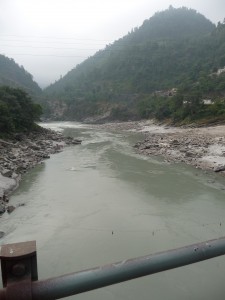
The road was beautiful and quiet, probably a result of the newer road that takes a detour, but doesn’t go through the hills. Less curves and less potholes make it attractive for trucks and buses, but on a motorcycle you need a road surface of no more than a metre wide, and curves are actually considered an advantage. The road winds through the hills to reach its highest point at Tansen after crossing the Kali Gandaka river, then descends to Butwal and on into the Terai, the plains that border on India. When I left Pokhara, I was hoping to reach Lumbini in the Terai – the Buddha’s birthplace. Seemed a fitting place to stay after a day’s riding on the highway named after his “worldly” name.
However, when the shadows grew long and the light turned grey, my map told me that my present location, the village Waling, was only about halfway to Tansen – which, I’d been told, would be the first place with accomodation. Not very keen on letting go of one of my good resolutions on the very first day – no riding in the dark if at all avoidable – I found myself lucky: there were a couple of hotels just a few metres from where I pulled over. I picked the cheapest one of the two very similar options. Apart from the swallows nesting in its restaurant, it was nothing special and not exactly clean, but it provided a place to sleep and they served me an excellent plate of dal bhat, lentils and rice.
Early the next morning I told the cockroach in my tankbag it was time to go, pushed my bike out of the shop where it had spent the night, and accelerated onto the foggy road. Riding through the clouds, between the lush green hills, I felt a little stiff, cruising in second gear at 30 kilometres an hour. A few hours later I found myself leaning through curves at 40 in third gear, apparently relaxing into the ride. Had another fantastic Nepali breakfast in hotel Nanglo West in Tansen – these people really know how to fry their potatoes.
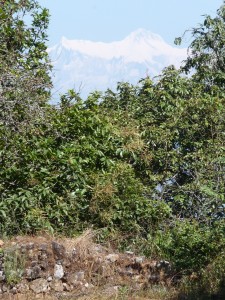
The friendly Canadian (that may be a pleonasm) I shared a table with had just returned from a walk up to the top of Srinagar Hill and claimed he saw snow peaks! Not wanting to miss the opportunity to finally verify the existence of those legendary and elusive mountains, I trudged up in the hot late morning sun, and was stupefied as soon as I got up there.
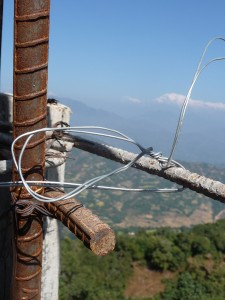
They exist! They actually exist! It’s not a digital-photography trick! So big… Very far away and still towering over everything, though towering isn’t actually the right word – nothing intimidating about them at all, they just sit there being high and white and rugged and majestic. A half finished concrete tower provided an excellent viewpoint. (As well as a breeding ground for a colony of enormous insects, a bizarre cross between wasps and giant ants, in a very skinny, stretched out way. If you know what I mean.)
Got back to my bike and was mildly relieved though not at all surprised that all my luggage and helmet were still there, and rolled down to Butwal. Ate my Nanglo chocolate roll (after dropping it onto the dirt, thank goodness for the three second rule) somewhere on the way in a spot with a beautiful view on the river (and full exposure to the now really baking sun – where were you in Pokhara?). I’m afraid a full month in Nepal didn’t get me any closer to understanding Gordon May’s love of Nepali cakes. I guess I just didn’t find the right bakeries.
Got to the Sonauli border without any further adventures. Sonauli is basically a bustling South Asian village with lots of people running in all directions, lots of truck honking as much as they can, and lots of dust. You have to really want to visit the border posts, actually make an effort to get stamped out of Nepal and into India. At customs the Nepali plates on a bike (“vee-HYE-kll”) ridden by a Dutchman with a carnet issued in England caused some confusion, but after a good one and a half hours I was wished a happy journey and advised to ride on to the next village, about 6 kilometres away, where they would actually have cash machines. This information discouraged all the money changing touts that were waiting for me outside, and I rode off optimistically.
In Nautanwah, the two first cash machines were hidden behind discouraging-looking shutters. The third one was located behind a large crowd of shouting and dancing Sikhs. I parked the bike and was invited into the police booth for tea and a chat and a great view of a Punjabi police marching band, the maitre leading his men into an elegant and sensual dance with his big fanfare cane. If the Dutch police force would have only the smalles measure of the swing of these guys, Holland would be a different country. Finally made it to an ATM, then, after filling my practically empty tank, I realised I would not get to the next village as it was already dark. finally, after a lot of getting lost, I arrived at a dirt cheap but somewhat dubious lodge very near the ATM I visited hours before.
mountains! please?
Last night in Pokhara, and I realised I didn’t know where to get a nice thukpa. This was after the restaurant I counted on for acces to their wifi network (conveniently available from my hotel room but in need of a password) turned out to be already closed. Bandipur déja-vu.
Pokhara was a mixed pleasure. Backpackistan avant la lettre, a koopgoot for crusty dreadlocked hippies and goretex trekkers. Enjoyably quiet restaurants serving pseudo-mexican (backpacksmex?) and borsht in semi-secluded cushioned booths. Cocky caucasian males racing down the street nonchalantly on small Honda motorcycles. Sugarily orchestrated “om mani padme hum” chants out of every shop, illy coffee available on every corner. And not a mountain in sight – it’s a scam to attract tourists, I knew it. But the hills are beautiful, and the upper Seti is a spectacular river – best to be enjoyed on a raft bouncing down the rapids. When the first wave is about to hit you you wonder why the hell you put yourself in this situation, and after that every fresh spraying of the bluegreen water only makes it better. Paddle! Forward! Get down! All back!
Got here on the already trusted Bullet. Great to get to know it, find out about its likes and dislikes. Of course it has some problems which I’m finding out about, but since the ride here went well – two up and our luggage – I have all faith in it.
Sadly, Rick and Moniek of Hearts & Tears were unexpectedly not in Pokhara. Would have been great to meet them after having been in touch on email for a while and meeting Rick in Kathmandu. Helpful, friendly, and full of useful information. Their colleague Sonu helped me, received the carnet for me and tracked down a good mechanic right after the Tihar and Deepavali festivities that sent most Enfield doctors to their homes in India. Boom has a little garage on a lot with a showroom or workshop of Orion dirt bikes (must be cool to take one of those high, skinny, light bikes into the field). I told him what bothered me and mentioned going to India tomorrow. More than three quiet hours later (punctuated with great-smelling sweet clove tea (black, no milk) in the same glass mugs my parents have at home – they’re everywhere in this place!), my bike had had an oil change, the intermediate clutch plates had been scratched with a saw blade to improve friction, transmission adjusted, air filter and carburettor cleaned, brake-shoes sanded and brakes adjusted and whatever else it took to make it ready for the road, without going into actually replacing parts. At a fair price and done with great care and patience and attention, this was exactly what I had hoped to ask for. Ready for India!
On this last night, Restaurant Manamakama turned out to be still open for business as well as serving a good veg thukpa (though I’m still missing the Revolution Café’s spicy red version). Happily off-edge thanks to a neighbour’s small brown gift, I came home to pack and prepare the road-videoclip for uploading. (What’s this with the new version of everything? Do I really need to discover all the things my Tiger iMovie didn’t have that I doubtlessly need?) Ready for tomorrow – first long ride alone, looking forward. I hear the road is beautiful and quiet. Gorakhpur is apparently an easy goal – though my estimated time of departure will be somewhat later than initially hoped – need to find a memory card to replace my camera’s suddenly unresponsive one, find internet, get a keyring. The hip kind that’s long enough to be clasped to your mirror, so the police can’t take your keys away. Not that I’m counting on getting into trouble – all I need to do is get that intimidating carnet stamped.
lalala – a week in katmandu
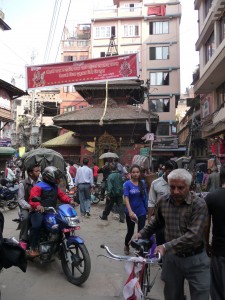
Two crows in a tree are fighting over a flattened rat. I don’t quite get the excitement – just how nutritious can that dried out piece of fur still be? Or is this just about prestige? But it’s an entertaining spectacle I’m watching from behind my regular breakfast – omelet on toast and black tea, on the roof terrace of the lovely Souvenir Guesthouse, in Katmandu’s tourist ghetto Thamel. The morning sun feels comfortably warm on my skin and around me, the flower pots are steaming after having been cared for by the gardener. Every morning he waters the large & colourful collection of plants on the roof terrace, picks the dead leaves, and today he’s painting the pots a nice teracotta. The daily smell of frying garlic drifts by – someone somewhere likes to start cooking early. Sometimes with a hint of peanut, other times coconut or chili. The House of Music across the street fills the air with happy Bollywood tunes or cheesy techno (including an inspired version of the lambada).
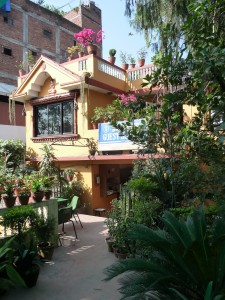
The air is chilly, getting noticeably colder every day. But the sun is still hot, up to 29 degrees yesterday. Every day as I walk out I realise I should have put sunscreen on my head. And every afternoon, when the shadows get longer, I realise I should have brought more clothes. More clothes would’ve definitely been welcome on my way to the Jazzmandu Festival in Gokarna (did you also think that was a South Indian beach resort?): it’s cold outside the smog! And never take the same road twice? Well, thanks for the advice ,Neil, but I don’t know how many times I went back and forth between one unknown village and another, it took me only two hours to get there. Reminded me of Gemma telling Clay of the Sons of Anarchy that he needs a gps to find the way from his home to the driveway. No problem though: I was having a fantastic time cruising around on unknown village roads on my two-wheeled sowing machine du jour, a 100 cc Honda Splendor. Fantastic bike for this somewhat chaotic traffic, small and light and manoeuvrable. It was my first ride in the country side, my first non-city, not-only-functional ride since I got here. Smells of cumin and sewage, the hills, the chills of the light rain. Even met some old friends of the Mercedes family, reminding me of my yellow friend who’s at home waiting for an engine transplantation.
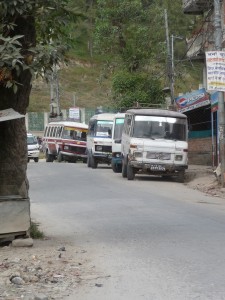
Eventually I walked in halfway through the concert by Window Seat, a fantastic quartet from Bombay. Quirky, skilled, busy, nuanced… For me the highpoint of the day, though that doesn’t mean the rest wasn’t good. The green lawns of the resort and the comfortable company of Dutch travellers and expats formed the perfect environment. Despite darkness and pot holes and the just-met passenger, the way back didn’t take more than twenty minutes. (Until I was on my own again, of course.) A most enjoyable way to conclude my first week in Kathmandu, Nepal, where I came to find an Enfield motorcycle.
monday match
Dancer Irene van Geest and myself were honoured being asked to curate a Monday Match, a night in the montly series of music & dance improvisation at the Amsterdam Bimhuis.
We were very happy to get a large & inspiring cast together:
Peter Cseri, Lily Kiara, Silvia Bennett, Yannick Greweldinger, Irene van Geest (movement), Felicity Provan (voice & trumpet), Ned McGowan (flutes), Fabrizio Colonna (guitar), Rob Kloet (drums), Robbert van Hulzen (drums)
[slideshow post_id=”1081″ exclude=”1405,1384″]
all photographs by joris hol
underwear gig @ studio 7, 12 august 2011
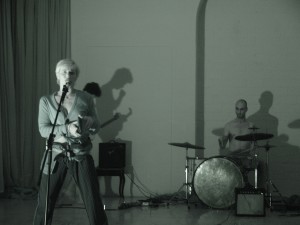
Before rushing off to the Buurtboerderij to jam on Pumporgan tunes with Dirk Bruinsma, Jasper Stadhouders, and John Dikeman, I had the honour of playing in Sharon Smith’s rock band in Studio 7, put together by the inimitable Katie Duck.
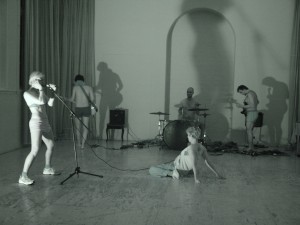
El Torrero on electric bass (an object previously known as an electric bass, by the end of the show), Grandma Fred on guitars, effects, and pseudoporn, and yours truly a.k.a. John the Robbert on drums. Of course it was loud, over the top, fantastic in many ways, and too long.
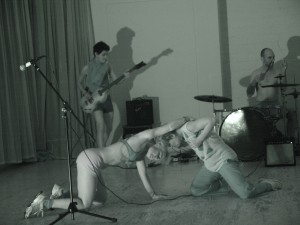
dikeman & van der weide & van hulzen @ fat form, 6 august 2011
Breed begrip: an instant jazz trio on a rainy roof in Amsterdam Bijlmer. Enveloped by the smell of chocolate brownies, the sound of heavy summer (?) rain, and the curious attention of a varied audience, saxophonist John Dikeman, cellist Raoul van der Weide, and I, drummer Robbert van Hulzen, improvised a half-hour long set of high-energy honks, heavy grooves that didn’t quite add up, crackles in honour of Michel Waisvisz, hisses of unknown origin, and gooey drones.
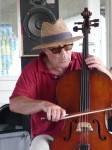 |
 |
 |
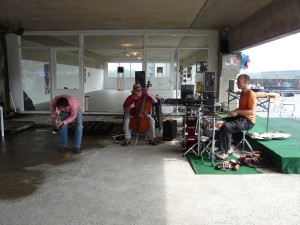 Our performance was part of the almost-weekly events organised by independent artists’ collective fatform: “an art project that challenges the idea of a traditional platform and at the same time uses its basic functionality. Local and international artists meet, exchange, exhibit and perform together during the whole summer at one of the best underground locations in Amsterdam: the rooftop of the Kraaiennest Shopping Centre in Amsterdam-Zuidoost.” The idea is to attract audiences from diverse backgrounds “such as contemporary art, biology, hip hop, new media, philosophy, performance and reggae”, which are “encouraged (or basically forced) to at least have a peek at the other”. Or, in this inescapable case, listen to us. Fortunately, the idea is “to not try to minimize these incompatibilities [originating in the different backgrounds] but rather we would like to propose a form that is FAT enough to contain all radicals.”
Our performance was part of the almost-weekly events organised by independent artists’ collective fatform: “an art project that challenges the idea of a traditional platform and at the same time uses its basic functionality. Local and international artists meet, exchange, exhibit and perform together during the whole summer at one of the best underground locations in Amsterdam: the rooftop of the Kraaiennest Shopping Centre in Amsterdam-Zuidoost.” The idea is to attract audiences from diverse backgrounds “such as contemporary art, biology, hip hop, new media, philosophy, performance and reggae”, which are “encouraged (or basically forced) to at least have a peek at the other”. Or, in this inescapable case, listen to us. Fortunately, the idea is “to not try to minimize these incompatibilities [originating in the different backgrounds] but rather we would like to propose a form that is FAT enough to contain all radicals.”
riding the bullet in south india, february 2011
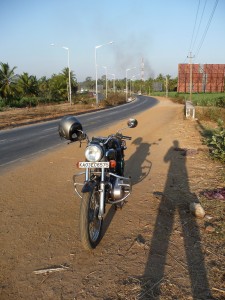
When on the train that previous time, she and I had a little sms-conversation, which resulted in a minor misunderstanding: when I picked up the bike, it turned out to be a “reversed feet” model: brake on the left, gear shift on the right. One up, three four five down. So on top of wearing shorts and slippers (where I’d faithfully been wearing my kevlar-lined jeans and motorcycle boots on my cute 100 cc Hero Honda in steaming Madras), I had to relearn my reflexes. Hm hm.
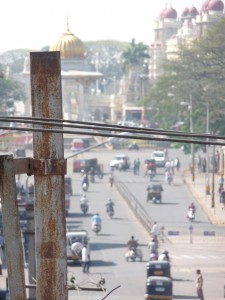
But I tried thinking of it as reorchestrating a drum groove, and it was surprisingly easy. A blessing in disguise: it took away my worries about this aspect of the overland India-to-Europe trip, which will have to be done on a bike like this. Dutch rules & regulations make it virtually impossible to import a bike from after 1998, and the older models all have the British layout for the feet. (Ever had to quickly put a foot down in a U-turn whilst still using the rear brake? Then you know why this design makes sense in England as well as India, where after all they drive on the wrong side of the road.)
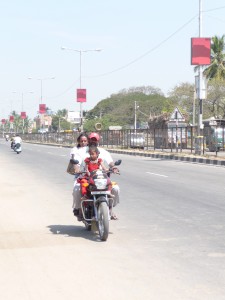
those fucking fish, what is it with those fucking fish, man
It’s unbelievable. You look at the sea. You swim in the sea. You stick your feet wash your hands cool your skin get salty make love get sunburnt in the sea. But then that’s not actually in the sea. It’s more on the sea. In-the-sea is another word for outer-space. There is this funny film – this mirror this membrane this giant ear drum if you will that separates the world as I know it from something of incredible, alien beauty.
A snorkelling trip seemed a good idea, after I spent a few days wondering around Gili Air, Indonesia. Got there when looking for a quiet place to get some work done for a few days after running around on Mount Rinjani. Getting very annoyed with Gili Trawangan, I ended up leaving my hotel room there, booking the next boat to any other island and whiling away the waiting hours eating food that was too expensive and very good. Reading my book on developing skills in musical improvisation by Paul Berliner. Amazing. Very insightful, very thoughtful and thought provoking. And very long winded. Please, mister Berliner, say what you want to say and leave it at that. Makes the whole story a lot clearer and, perhaps surprisingly because leaving out so much evidence and illustration, more informative.
I spent my evenings and a lot of the daytime on reading the book. Walking around the island took a few hours and walking was a great way to get places and get lost. Banana plantations, a village that might have been a compound or someone’s garden, beach beach beach. And tourist restaurants. All selling the same stuff and all at least acceptable. No jack fruit curry though, contrary to the menu of a cosy little beach place I sat down in with high hopes. Ended up in a fancy place further up (or down?) the beach, eavesdropping on conversations of diving instructors.
After contemplating booking the snorkelling tour with the same happy player of a broken guitar that I booked my transport to the airport a day after with, I ran into … no idea of his name anymore. Grr. Dutch guy who lived in Australia since years, with an Australian lady and their children. Or was it New Zealand. Huub, I think he was called. Bought five euros worth of rupees from him a while later. (Being able to eat at airports is important.) Huub told me about the amazing snorkelling right off the beach, and added that that was principally where the trips were going. Also another place just like it, and a place where the big turtles live. But: there are turtles here too! He saw one just a while before.
The next day I rented flippers and a diving mask and snorkel from the friendly guy who all of a sudden charged five thousand rupees more than what he quoted before – and not only him, it turned out, and not only to me. Apparently, a step up on the tourism calendar hierarchy that day. Still, he seemed quite happy with my advance of twenty and never mentioned the remainder again.
I walked up the beach to the corner, where the island turns left. One of the curves in the island, just north of the fancy tourist area. (As distinguished from the easy-going, the hippie, and the posh beaches.) Put my costume on, and stuck my head under water. Nice. Sea floor with plants, very shallow but friendly. Reminds me of looking under water in Switzerland when I was little (with the diving mask I had worn to a restaurant dinner the day I had bought it). And then the floor dips down and nothing is similar to anything you’ve seen. To quote Ewan McGregor, I felt like I was in National Geographic, I was National Geographic! Different world. Different light. Kind of hushy dark blue, very clear in a foggy way. It’s not that it’s unclear, but you still can’t see very far. Sunlight filtering in. And reflecting off of everything that lives there… Different breath. Breathing only through your mouth, with a rasp that keeps getting stronger until you realise you have to take the water out of the snorkel. Breathing deeply is difficult, something I always find difficult in water. The reason why I still can’t crawl in the water, and failed miserably at a diving lesson years ago. Just don’t know how to breath out. Panic breath in panic breath in PANIC BREATH IN. Exhaling is not on the menu. With a snorkel it’s a lot easier though, and it’s fantastic to finally relax and let the breathing take over, let it happen on its own without worrying about it.
Different sound under the water surface too. Muffled, and reverby. Or resonant, rather. Tiny pinpricks of bubble sound. The whoosh of flippers, delayed. Different physique. Being horizontal is cool. Being able to keep your neck long, into the back of your head, and have your head looking straight down, is fantastic because you can totally relax and breath and be active at the same time, the relaxation making you stronger.
And while floating and propelling yourself into this deep blue world of sci-fi sound and movement that may be very primal for us (after all, some of us believe our species lived in the sea for a while and their evidence seems credible), you meet Nemo and all his friends. I didn’t have my motorbike licence yet, but I was the Motorcycle Boy. Only I hadn’t known till then that this is in a different category of colour management. Unbelievable combinations of purple blue orange red yellow silver and all kinds of other shades and hues I never knew existed. And all shiny and contrasting and complementing and making that world somehow so coherent and so independent.
I went three times, with a little break after the second time. In which I sold a book (given to me by Tessel thirteen years before, I took a picture of what she wrote in it) and kept the two tens in my pocket while going the third time. My ignoring the slighly hot feeling on the skin of my back led to a very welcomed aloe vera treatment the next day, when my lobster skin didn’t enjoy the backpack. Leaving the island, leaving Lombok and Rinjani, and a few hours later flying away fom the airport of Jakarta with its Starbuck’s, where they take credit cards and provide wifi, and the usual airport bookshop.

